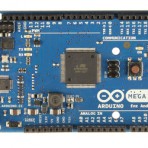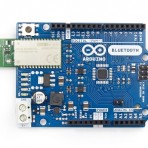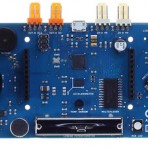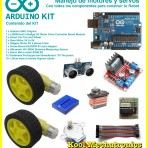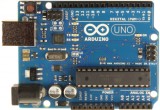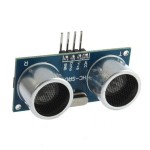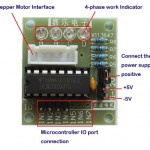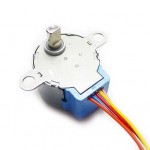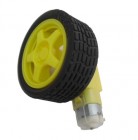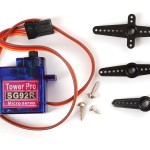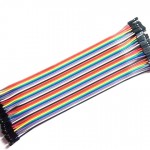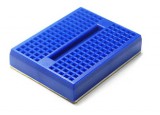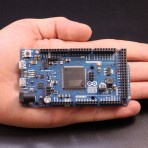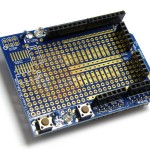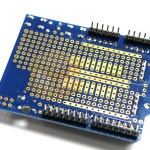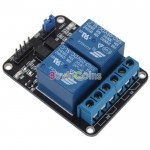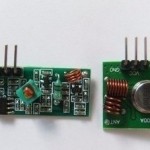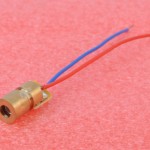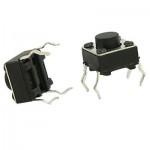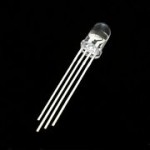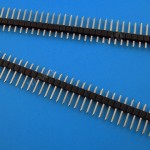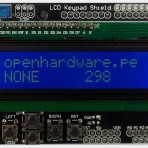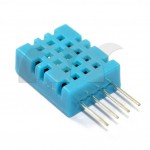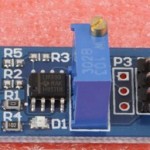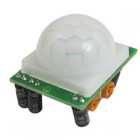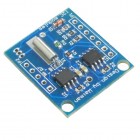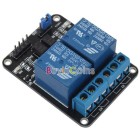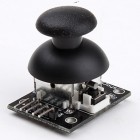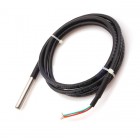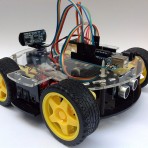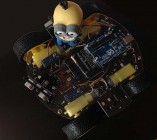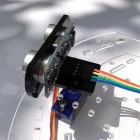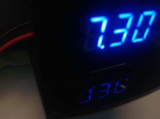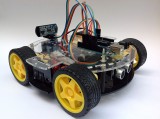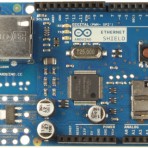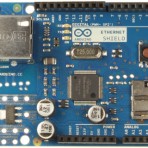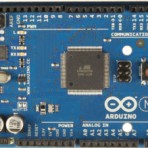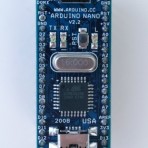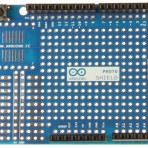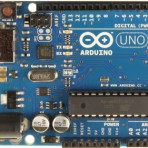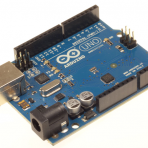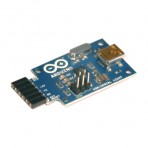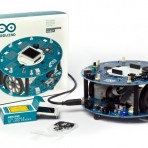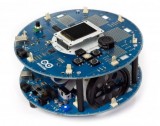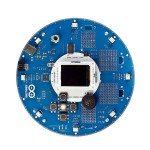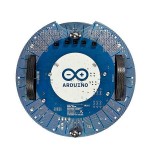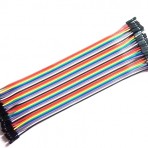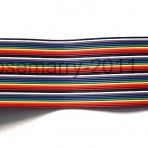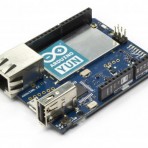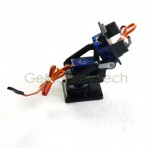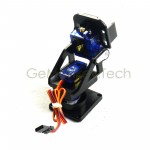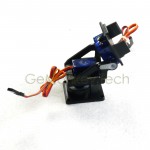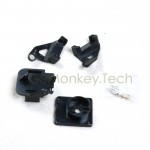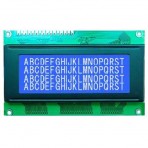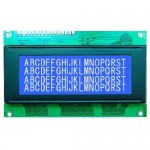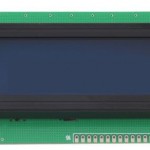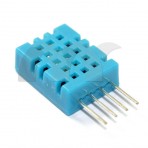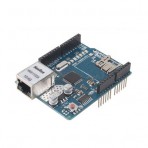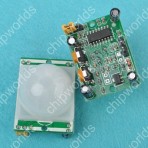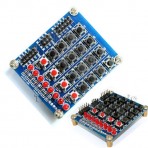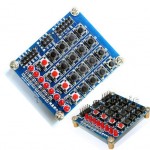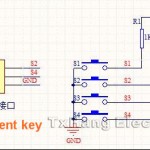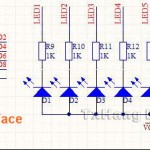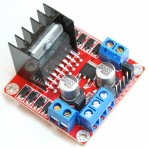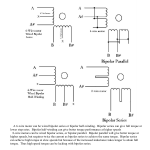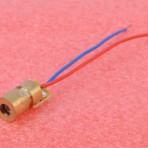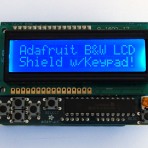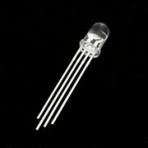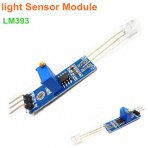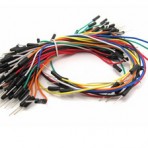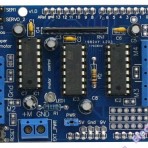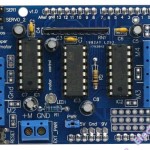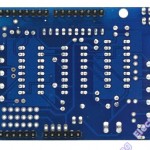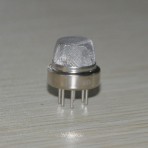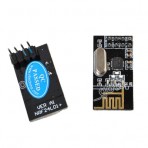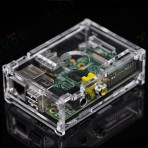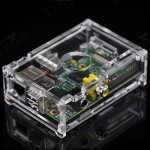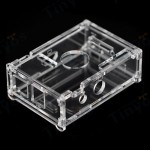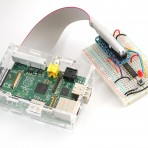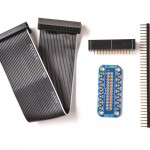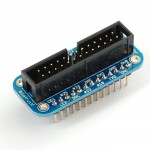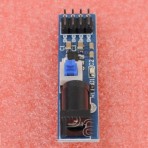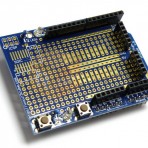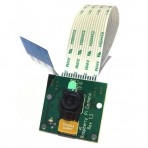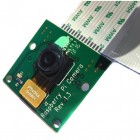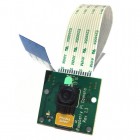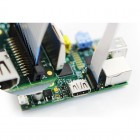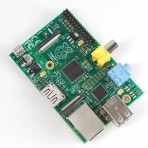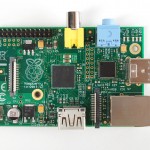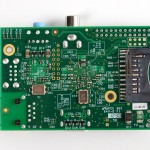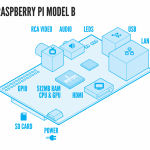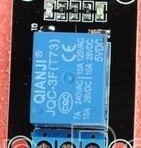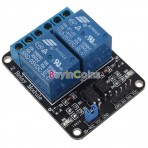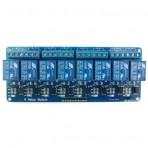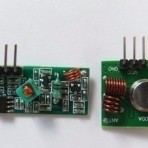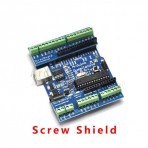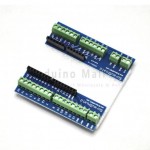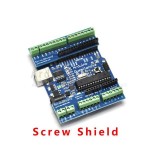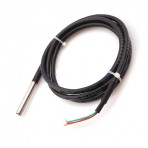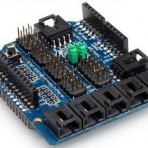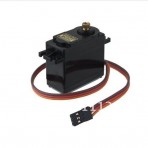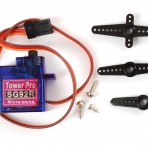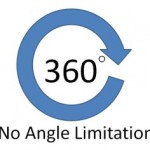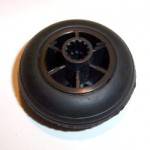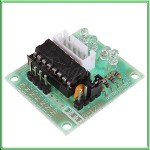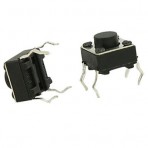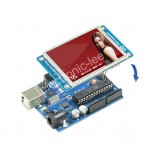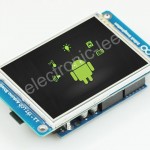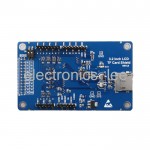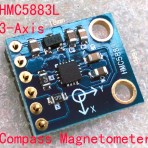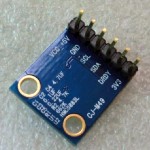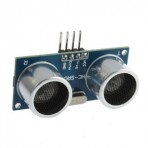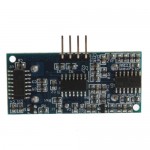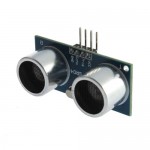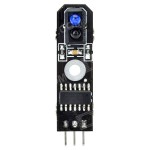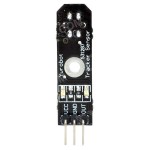Arduino
Arduino es una plataforma de electrónica abierta para la creación de prototipos basada en software y hardware flexibles y fáciles de usar. Se creó para artistas, diseñadores, aficionados y cualquiera interesado en crear entornos u objetos interactivos.
Arduino puede tomar información del entorno a través de sus pines de entrada de toda una gama de sensores y puede afectar aquello que le rodea controlando luces, motores y otros actuadores.
El microcontrolador en la placa Arduino se programa mediante el lenguaje de programación Arduino(basasdo en Wiring) y el entorno de desarrollo Arduino (basado en Processing).
Los proyectos hechos con Arduino pueden ejecutarse sin necesidad de conectar a un ordenador, si bien tienen la posibilidad de hacerlo y comunicar con diferentes tipos de software (p.ej. Flash, Processing, MaxMSP).
Open Hardware SAC (Ideasmultiples LABS) es distribuidor oficial de Arduino para Perú, solamente distribuimos Microcontroladores Arduino Originales.
Arduino ADK Rev3
La ADK Arduino es una placa electrónica basada en el microprocesador ATmega2560 (datasheet). lleva una USB para conectar los telefonos que estan basado en Android.
Es compatibile con los ejemplos contenidos en el Android Accessory Development Kit. Cuenta con 54 entradas / salidas digitales pines (de los cuales 14 se pueden utilizar como salidas PWM), 16 entradas analógicas,4 UARTs (puertos serie de hardware), un oscilador de cristal de 16 MHz, una conexión USB, un conector de alimentación, un conector ICSP y un botón de reset.
La ADK es basada en la Mega 2560. Ademas lleva un circuito USB que permite a esta placa de comunicarse con los dispositivos USB, y suministrarle tambien alimentazion.
Las características adicionales que vienen con la versión R3 son:
- ATmega 16U2 en vez de 8U2 como convertidor USB serial.
- 1.0 pinout: añadido SDA y SCL pines para TWI comunicación colocada cerca al pine AREF y dos pasadores de otras nuevas colocadas cerca del pine RESET, el IOREF que permiten que los escudos para adaptarse a la tensión proporcionada por la junta directiva y el segundo un no conectado pin, que se reserva para usos futuros.
- REINICIO del circuito mas fuerte.
Especificaciones técnicas
| microprocesador | ATmega2560 |
| Tensión de funcionamiento | 5 V |
| Voltaje de entrada (recomendado) | 7-12V |
| Voltaje de entrada (limites) | 6-20V |
| Digital I/O Pines | 54 (de los cuales 14 proporcionan salida PWM) |
| Pines de entrada analógica | 16 |
| DC Corriente por I/O Pine | 40 mA |
| DC Corriente por 3.3V Pine | 50 mA |
| Memoria flash | 256 KB di cui 8 KB de los cuales 8 KB utilizadas por bootloader |
| SRAM | 8 KB |
| EEPROM | 4 KB |
| Velocidad de reloj | 16 MHz |
Para informaciones sobre el uso de la placa con el sistema operativo Android, hecha un vistazo en (documentación de Google ADK), para mas informaciones sobre la placa puede ver la pagina Mega ADK En la sección Hardware.
Arduino BT (Bluetooth)
El Arduino BT es una placa originariamente basada sobre el ATmega168, pero ahora esta basada sobre el ATmega328 (datasheet) y el modelo bluetooth Bluegiga WT11 (detalles y datasheet [pdf]). Permite una comunicacion seriale sin cables atraves el bluetooth (pero no es compatible con auriculares bluetooth o otros dispositivos). Tiene 14 I/O digitales (6 de los cuales pueden ser utilizados como salida PWM, uno para reiniciar el modulo WT11 sobre la placa), 6 input analogicos, un cristal de 16Mhz, terminales de potencia, una cabecera ICSP, un botón de reinicio. Tiene todo lo necesario para apoyar el microcontrolador y se puede programar a través de la conexión Bluetooth. Instrucciones disponibles (en ingles) en la sección getting started with the Arduino BT.
Especificaciones técnicas
| Microcontrolador | ATmega328 |
| Tension de operación | 5V |
| Tensión de entrada | 2.5-12V |
| I/O digitales | 14 (6 de lo cuales con salida PWM) |
| entradas analogicas | 6 |
| Corriente de salida para I/O Pin | 40 mA |
| Corriente de salida para 3.3V Pin | 500 mA (con sorgente a 1.5A) |
| Corriente de salida para 5V Pin | 1000 mA (con sorgente a 1.5A) |
| Flash Memory | 32 KB (of which 2 KB used by bootloader) |
| SRAM | 2 KB |
| EEPROM | 1 KB |
| Clock Speed | 16 MHz |
| Modulo BT | 2.1 WT11i-A-AI4 |
Para obtener una descripción más detallada sobre su placa usted debe visitar la página oficial Arduino Bluetooth page en la sección Hardware.
Power
The Arduino BT can be powered via the V+ and GND screw terminals. The board contains a DC-DC convector that allows it to be powered with as little as 2.5V, a maximum of 12V. Higher voltages or reversed polarity in the power supply can damage or destroy the board. The protection for reverse polarity connection is ONLY on the screw terminal. The power pins are as follows:
- +VIN. The input voltage to the Arduino board (i.e. the same as the V+ screw terminal). You can supply voltage through this pin, or, if supplying voltage via the screw terminals, access it through this pin. Warning: The protection for reverse polarity connection is ONLY on the screw terminal, do not attach negative voltages to this pin. It will damage the board.
- 5V. This pin outputs a regulated 5V from the regulator on the board. The board can be supplied with power either from the screw terminal (2.5V – 12V) or the VIN pin of the board (2.5V-12V). Supplying voltage via the 5V or 3.3V pins bypasses the regulator, and can damage your board. We don’t advise it.
- GND. Ground pins.
Memory
The ATmega328 has 32 KB of flash memory for storing code (of which 2 KB is used for the bootloader). It has 1 KB of SRAM and 512 bytes of EEPROM (which can be read and written with the EEPROM library).
Input and Output
Each of the 14 digital pins on the BT can be used as an input or output, using pinMode(), digitalWrite(), and digitalRead()functions. They operate at 5 volts. Each pin can provide or receive a maximum of 40 mA and has an internal pull-up resistor (disconnected by default) of 20-50 kOhms. In addition, some pins have specialized functions:
- Serial: 0 (RX) and 1 (TX). Used to receive (RX) and transmit (TX) TTL serial data. These pins are connected to the corresponding pins of the Bluegiga WT11 module.
- External Interrupts: 2 and 3. These pins can be configured to trigger an interrupt on a low value, a rising or falling edge, or a change in value. See the attachInterrupt() function for details.
- PWM: 3, 5, 6, 9, 10, and 11. Provide 8-bit PWM output with the analogWrite() function.
- SPI: 10 (SS), 11 (MOSI), 12 (MISO), 13 (SCK). These pins support SPI communication, which, although provided by the underlying hardware, is not currently included in the Arduino language.
- BT Reset: 7. Connected to the reset line of the Bluegiga WT11 module, which is active high.
- LED: 13. There is a built-in LED connected to digital pin 13. When the pin is HIGH value, the LED is on, when the pin is LOW, it’s off.
The BT has 6 analog inputs, each of which provide 10 bits of resolution (i.e. 1024 different values). By default they measure from ground to 5 volts, though is it possible to change the upper end of their range using the AREF pin and some low-level code. Additionally, some pins have specialized functionality:
- I2C: 4 (SDA) and 5 (SCL). Support I2C (TWI) communication using the Wire library (documentation on the Wiring website).
There are a couple of other pins on the board:
- AREF. Reference voltage for the analog inputs. Used with analogReference().
See also the mapping between Arduino pins and ATmega168/328 ports.
Bluetooth Communication
The Bluegiga WT11 module on the Arduino BT provides Bluetooth communication with computers, phones, and other Bluetooth devices. The WT11 communicates with the ATmega328 via serial (shared with the RX and TX pins on the board). It comes configured for 115200 baud communication. The module should be configurable and detectable by your operating system’s bluetooth drivers, which should then provide a virtual com port for use by other applications. The Arduino software includes a serial monitor which allows simple textual data to be sent to and from the Arduino board over this bluetooth connection. The board can also be reprogrammed using this same wireless connection. The WT11 is specially configured for use in the Arduino BT. Its name is set to ARDUINOBT and passcode to 12345. For details, see the complete initialization sketch.
Communication
The Arduino BT has a number of other facilities for communicating. The ATmega328’s UART TTL (5V) serial communication is available on digital pins 0 (RX) and 1 (TX) as well as being connected to the WT11 module. A SoftwareSerial library allows for serial communication on any of the BT’s digital pins. The ATmega328 also supports I2C (TWI) and SPI communication. The Arduino software includes a Wire library to simplify use of the I2C bus; see the documentation on the Wiring website for details. To use the SPI communication, please see theATmega328 datasheet.
Programming
The Arduino BT can be programmed with the Arduino software (download). For details, see the reference and tutorials. The ATmega328 on the Arduino BT comes preburned with a bootloader that allows you to upload new code to it without the use of an external hardware programmer. It communicates using the original STK500 protocol (reference, C header files). You can also bypass the bootloader and program the ATmega328 through the ICSP (In-Circuit Serial Programming) header; see these instructions for details.
Physical Characteristics
The maximum length and width of the BT are approximately 3.2 and 2.1 inches respectively. Three screw holes allow the board to be attached to a surface or case. Note that the distance between digital pins 7 and 8 is 160 mil (0.16″), not an even multiple of the 100 mil spacing of the other pins.
Arduino Esplora
El Arduino Esplora es una placa ya lista para usar, muy fácil de manejar, que te permite explorar un sinfín de posibilidades que hay en el mundo de los sensores y actuadores, sin tener que usar breadboards (protoboards), soldadores o cables.
No hay límites para las aplicaciones educativas y divertidas que puedes desarrollar. Si lo necesitas puedes agregar además un par de sensores y actuadores adicionales. ¡Añadiendo un módulo LCD de colores podrás crear video juegos divertidos en tu propia consola de código abierto!
El Arduino Esplora combina el procesador Arduino con una gama de sensores y actuadores incluidos :
- sensores de luz
- sensores de temperatura
- accelerometros de 3 ejes
- joystick
- pulsadores
- potenciometros lineares
- leds RGB
- zumbadores
El Arduino Esplora puede emular un ratón o un teclado, te permite crear tu propio controlador de software para música, herramientas 3D, o incluso un procesador de textos. El Arduino Esplora viene ya pre-programado con una secuencia de instrucciones de juego, así que tan pronto como lo conectes a tu ordenador puedes comenzar a jugar de inmediato. Para más detalle por favor visita arduino.cc/esplora.
Detalles tecnicos
| Microcontroller | ATmega32u4 |
| Operating Voltage | 5V |
| Flash Memory | 32 KB of which 4 KB used by bootloader |
| SRAM | 2.5 KB |
| EEPROM | 1 KB |
| Clock Speed | 16 MHz |
Lleva incluido el cable MICRO USB.
The Arduino Esplora is a microcontroller board derived from the Arduino Leonardo. The Esplora differs from all preceding Arduino boards in that it provides a number of built-in, ready-to-use setof onboard sensors for interaction. It’s designed for people who want to get up and running with Arduino without having to learn about the electronics first. For a step-by-step introduction to the Esplora, check out the Getting Started with Esplora guide.
The Esplora has onboard sound and light outputs, and several input sensors, including a joystick, a slider, a temperature sensor, an accelerometer, a microphone, and a light sensor. It also has the potential to expand its capabilities with two Tinkerkit input and output connectors, and a socket for a color TFT LCD screen.
Like the Leonardo board, the Esplora uses an Atmega32U4 AVR microcontroller with 16 MHz crystal oscillator and a micro USB connection capable of acting as a USB client device, like a mouse or a keyboard.
In the upper left corner of the board there is a reset pushbutton, that you can use to restart the board. There are four status LEDS :
- ON [green] indicates whether the board is receiving power supply
- L [yellow] connected directly to the microcontroller, accessible through pin 13
- RX and TX [yellow] indicates the data being transmitted or received over the USB communication
The board contains everything needed to support the microcontroller; simply connect it to a computer with a USB cable to get started.
Schematic & Reference Design
EAGLE files: Attach:arduino-esplora-reference-design.zip
Schematic: Attach:arduino-esplora-schematic.pdf

Memory
The ATmega32u4 has 32 KB (with 4 KB used for the bootloader). It also has 2.5 KB of SRAM and 1 KB of EEPROM (which can be read and written with the EEPROM library).
Input and Output:
The design of the Esplora board recalls traditional gamepad design with an analog joystick on the left and four pushbuttons on the right.
The Esplora has the following on-board inputs and outputs :
- Analog joystick with central push-button two axis (X and Y) and a center pushbutton.
- 4 push-buttons laid out in a diamond pattern.
- Linear potentiometer slider near the bottom of the board.
- Microphone for getting the loudness (amplitude) of the surrounding environment.
- Light sensor for getting the brightness.
- Temperature sensor reads the ambient temperature
- Three-axis accelerometer measures the board’s relation to gravity on three axes (X, Y, and Z)
- Buzzer can produce square-waves.
- RGB led bright LED with Red Green and Blue elements for color mixing.
- 2 TinkerKit Inputs to connect the TinkerKit sensor modules with the 3-pin connectors.
- 2 TinkerKit Outputs to connect the TinkerKit actuator modules with the 3-pin connectors.
- TFT display connector connector for an optional color LCD screen, SD card, or other devices that use the SPI protocol.
In order to utilize the total number of available sensors, the board uses an analog multiplexer. This means a single analog input of the microcontroller is shared among all the input channels (except the 3-axis accelerometer). Four additional microcontroller pins choose which channel to read.
Communication
The Leonardo the Esplora has a number of facilities for communicating with a computer, another Arduino, or other microcontrollers. The ATmega32U4 provides serial (CDC) communication over USB and appears as a virtual com port to software on the computer. The chip also acts as a full speed USB 2.0 device, using standard USB COM drivers. On Windows, a .inf file is required. The Arduino software includes a serial monitor which allows simple textual data to be sent to and from the Arduino board. The RX and TX LEDs on the board will flash when data is being transmitted via the USB connection to the computer.
The ATmega32U4 also supports SPI communication, that can be accessed through the SPI library.
The Esplora can appear as a generic keyboard and mouse, and can be programmed to control these input devices using theKeyboard and Mouse libraries.
Programming
The Esplora can be programmed with the Arduino software (download). Select «Arduino Esplora» from the Tools > Board menu. For details, see the getting started page.
The ATmega32U4 on the Arduino Esplora comes preburned with a bootloader that allows you to upload new code to it without the use of an external hardware programmer. It communicates using the AVR109 protocol.
You can also bypass the bootloader and program the microcontroller through the ICSP (In-Circuit Serial Programming) header; see these instructions for details.
Esplora Library
To facilitate writing sketches for the Esplora, there is a dedicated library that contains methods for reading the sensors and writing to the outputs on-board.
The library offers high level methods which provide pre-processed data, like degrees Fahrenheit or Celsius from the temperature sensor. It also enables easy access to the outputs, like writing values to the RGB LED.
Visit the Esplora library reference page to see the complete documentation of the library and examples.
Automatic (Software) Reset and Bootloader Initiation
Rather than requiring a physical press of the reset button before an upload, the Esplora is designed in a way that allows it to be reset by software running on a connected computer. The reset is triggered when the Esplora’s virtual (CDC) serial / COM port is opened at 1200 baud and then closed. When this happens, the processor will reset, breaking the USB connection to the computer (meaning that the virtual serial / COM port will disappear). After the processor resets, the bootloader starts, remaining active for about 8 seconds. The bootloader can also be initiated by pressing the reset button on the Esplora. Note that when the board first powers up, it will jump straight to the user sketch, if present, rather than initiating the bootloader.
Because of the way the Esplora handles reset it’s best to let the Arduino software try to initiate the reset before uploading, especially if you are in the habit of pressing the reset button before uploading on other boards. If the software can’t reset the board you can always start the bootloader by pressing the reset button on the board.
USB Overcurrent Protection
The Esplora has a resettable polyfuse that protects your computer’s USB ports from shorts and overcurrent. Although most computers provide their own internal protection, the fuse provides an extra layer of protection. If more than 500 mA is applied to the USB port, the fuse will automatically break the connection until the short or overload is removed.
Physical Characteristics
The maximum length and width of the Esplora PCB are 6.5 and 2.4 inches respectively, with the USB and TinkerKitconnectors extending beyond the latter dimension. Four screw holes allow the board to be attached to a surface or case.
Arduino Kit : Manejo de motores y servos, componentes de robot
Este kit incluye un Arduino UNO y los tres tipos de motores que se utilizan habitualmente en mecatrónica, estandar, paso a paso y servo, con sus respectivos controladores, indispensable para aprender practicando, después de haber aprendido el uso de los motores, puedes montar tu propio robot con medidor de distancia para evitar obstaculos.
Incluye todos los componentes electrónicos y motores necesarios para armar un robot con sensor ultrasónico de distancia, es una excelente opción para practicar y aprender con nuestro Arduino.
Contenido del KIT:
- 1 x Arduino UNO Original
- 1 x L298N Dual H Bridge DC Stepper Motor Drive Controller Board Module
- 2 x Smart Car Tire and Wheel
- 2 x Gear Motor 5V a 9V
- 1 x Stepper Motor 5V 4-phase 5 line
- 1 x Driver Board ULN2003 5V para stepper de 4-phase 5 line
- 1 x Ultrasonic Module HC-SR04 Distance Measuring Sensor
- 1 x Servo Micro small SG90 9G
- 1x Solderless Prototype mini Breadboard 170 Tie-points
- 10 × 20cm male to female Dupont cables
El kit incluye solamente el Arduino UNO y los componentes electrónicos necesarios para el robot, no incluye el chasis para robot, puedes utilizar cualquier chasis de robot, juguetes o incluso hacerlo con un CD si sigues este tutorial.
Arduino Kit Avanced Learning
Este Kit pone al alcance de tus manos todos los componentes necesarios para convertirse en un usuario avanzado de Arduino, motores paso a paso, medición de distancias con un sensor de Ultrasonidos, relés de potencia para interactuar con dispositivos de consumo, pulsadores, leds multicolor y comunicaciones entre dispositivos
Incluye una Shield para crear prototipos fijos personalizados que permite soldar componentes discreos directamente en la placa.
Incluye:
- 1 x Assembled Prototype Wiring Shield v.5 for Arduino
- 1 x Dual H Bridge DC Stepper Motor Drive Controller L298N for Arduino
- 1 x Stepper Motor 5V 4-phase 5 line
- 1 x Driver Board ULN2003 5V 4-phase 5 line
- 1 x Ultrasonic Module HC-SR04 Distance Measuring Sensor
- 1 x 5V 2-Channel Relay Module for Arduino
- 1x 433Mhz RF transmitter and receiver link kit for Arduino/ARM/MCU WL
- 10 x Tact switch push button 6×6×H9(mm )
- 5 x LED RGB Clear Common Cathode
- 2 x mini 650nm 6mm 5V 5mW Laser Dot Diode Module Head WL Red*
- 2 x Pitch 2.54mm 40 Pin Male Single Row Straight Pin Header Strip
No incluye la placa Arduino
*No conectar directamente a los pines de Arduino, debido a su consumo es necesario utilizar un transistor de potencia para manejarlo.
Este laser es de 5MW de potencia, debe de tener cuidado al manipularlo y nunca apuntar directamente a los ojos.
Arduino Kit display & sensores
- Este kit incluye Un Arduino UNO R3, Un Display Shield de dos líneas de 16 caracteres con 5 pulsadores integrados, un modulo RTC (reloj de tiempo real) con batería y un conjunto de sensores para practicar y aprender como recoger datos del exterior, temperatura, humedad, distancia, además de un relay doble para controlar dispositivos de potencia, como luces, y un joystick.Con los componentes de este kit aprenderás a medir temperatura, controlar la humedad, detectar el movimiento, medir distancias, controlar el tiempo y escribirlo en un display LCD, ademas de manejar dispositivos de potencia, como luces o ventiladores, incluso puedes montar tu propia estación metereológica.
Incluye:
- 1 x Arduino Uno Rev3
- 1 x Shield con display LCD de 16×21602 y teclado
- 1 x Módulo de reloj de tiempo real RTC, I2C DS1307 AT24C32 + batería LIR2032
- 1 x Sensor HC-SR501 Human Sensor Pyroelectric Infrared
- 1 x Medidor ultrasónico de distancia HC-SR04
- 1 x Módulo de doble Relay AC250V 10A
- 1 x Sensor de humedad y temperatura DHT11
- 1 x Termómetro digital impermeable DS18B20
- 1x Sensor Hall para control de velocidad en motores
- 10 × 20cm male to female Dupont cables
ARDUINO KIT KM82 SMART ROBOT CART LEARNING
Incluye todos los componentes necesarios para armar un completo robot con sensor ultrasónico de distancia, es una excelente opción para practicar y aprender con nuestro Arduino.
Una Shield para controlar 2 servos, 2 motores paso a paso o 4 motores estándar, el kit incluye los dos motores necesarios para montar el robot.
El kit incluye tods los componentes electrónicos necesarios para el robot, incluido el chasis para robot, los motores y hasta el portapilas.
y por supuesto, también incluye un Arduino UNO
Arduino Original DUE
La placa Arduino DUE es la nueva adición a la familia Arduino. Esta es la primera tarjeta que utiliza el procesador con núcleo ARM de 32 bits Atmel SAM3X8E ARM Cortex-M3 MCU, lo cual mejora las capacidades estándard de Arduino y añade nuevas y emocionantes características.
La tarjeta dispone de 54 entradas/salidas digitales (de las cuales 12 se pueden utilizar como salida PWM, con la posibilidad de elegir la resolución), 12 entradas analógicas con resolución de 12 bits, 4 UARTs (puertos serie de hardware), 2 salida DAC (convertidores de analógico a digital), velocidad del reloj de 84 MHz, 2 conectores USB, un conector de alimentación, un conector ICSP, un conector JTAG y un botón de reset (reinicio). La tensión máxima de los pines de Entrada/Salida es de 3,3 Voltios. Nunca utilizar un voltaje más alto, tales como 5 Voltios en un pin de entrada, puesto que puede causar daños a la placa.
Uno de los dos conectores USB, el micro-USB es el nativo y puede funcionar como un host USB. Esto significa que se puede conectar otros dispositivos USB a la tarjeta, tal como ratones, teclados y teléfonos inteligentes. El otro conector USB, de tipo B, se ha diseñado con fines de debug (verificar la operación del programa, probar e interceptar posibles errores.
The Due has two usb connectors, the one with the micro-usb AB connector is the native one capable to act as an USB host, that means you can connect compatible external usb peripherals to the board, such as mouse, keyboards, smartphones. While the other USB port with the type B connector is intended for debugging purposes. If you want to give a closer look to this board we advise you to visit the officialArduino Due page in the Products Section.
Technical Specifications
| Microcontroller | AT91SAM3X8E |
| Operating Voltage | 3.3V |
| Input Voltage (recommended) | 7-12V |
| Input Voltage (limits) | 6-20V |
| Digital I/O Pins | 54 (of which 12 provide PWM output) |
| Analog Input Pins | 12 |
| Analog Outputs Pins | 2 (DAC) |
| Total DC Output Current on all I/O lines | 130 mA |
| DC Current for 3.3V Pin | 800 mA |
| DC Current for 5V Pin | 800 mA |
| SRAM | 96 KB (64 + 32 KB) |
| Clock Speed | 84 MHz |
Arduino Original Ethernet Rev3 + usb 2 Serial
El Arduino Ethernet es una placa electrónica basada en el Arduino Uno, que incorpora una Ethernet W5100 WIZnet TCP / IP integrado. Se puede programar como una UNO a través de una serie de seis pines FTDI. Se puede utilizar el adaptador Arduino USB 2 Serial o cualquier tipo de cable FTDI para actuar como un convertidor de USB a puerto serie.
Las características adicionales que vienen con la versión R3 son:
- 1.0 pinout: añadido SDA y SCL pines para TWI comunicación colocada cerca al pine AREF y dos pasadores de otras nuevas colocadas cerca del pine RESET,se han colocado otros dos nuevos pines, el IOREF que permiten que los escudos para adaptarse a la tensión proporcionada por la junta directiva y el segundo un no conectado pine, que se reserva para usos futuros.
- REINICIO forzado del circuito.
Incluye en el precio el módulo Arduino USB 2 Serial Converter necesario para su programación por cable USB.
A separate power-over-Ethernet (PoE) module can be soldered to the board to provide power from a conventional twisted pair Category 5 Ethernet cable. It is IEEE802.3af compliant, and works with all compliant PoE injectors currently available. Additional features coming with the R3 version are:
- 1.0 pinout: added SDA and SCL pins for TWI communication placed near to the AREF pin and two other new pins placed near to the RESET pin, the IOREF that allow the shields to adapt to the voltage provided from the board and the second one is a not connected pin, that is reserved for future purposes.
- stronger RESET circuit.
Technical Specifications
| Microcontroller | ATmega328 |
| Operating Voltage | 5V |
| Input Voltage (recommended) | 7-12V |
| Input Voltage (limits) | 6-20V |
| Digital I/O Pins | 14 (of which 4 provide PWM output) |
| Analog Input Pins | 6 |
| DC Current per I/O Pin | 40 mA |
| DC Current for 3.3V Pin | 50 mA |
| Flash Memory | 32 KB (ATmega328) of which 0.5 KB used by bootloader |
| SRAM | 2 KB (ATmega328) |
| EEPROM | 1 KB (ATmega328) |
| Clock Speed | 16 MHz |
| W5100 TCP/IP Embedded Ethernet Controller | |
| Power Over Ethernet ready Magnetic Jack | |
| Micro SD card, with active voltage translators |
Arduino Pins reserved
- 10 to 13 used for SPI
- 4 used for SD card
- 2 W5100 interrupt (when bridged)
Arduino Original Ethernet Shield Rev3
The Arduino Ethernet Shield allows an Arduino board to connect to the internet. It is based on the Wiznet W5100 ethernet chip (datasheet). The Wiznet W5100 provides a network (IP) stack capable of both TCP and UDP. It supports up to four simultaneous socket connections. Use the Ethernet library to write sketches which connect to the internet using the shield. The ethernet shield connects to an Arduino board using long wire-wrap headers which extend through the shield. This keeps the pin layout intact and allows another shield to be stacked on top.
The R3 version brings to this shield the 1.0 standard pinout that consist in 4 additional pins: 2 of them placed near the AREF pin, that are used for TWI communication, and the other 2 are placed near the RESET pin. The IOREF pin is used to adapt the shield to the board on which is mounted. The last one is not connected and is reserved for future uses. The latest revision of the shield adds a micro-SD card slot, which can be used to store files for serving over the network. It is compatible with the Arduino Duemilanove and Mega (using the Ethernet library). It also adds a separate power-over-Ethernet (PoE) module can be soldered to the board to provide power from a conventional twisted pair Category 5 Ethernet cable. It is IEEE802.3af compliant, and works with all compliant PoE injectors currently available.
Arduino Original Leonardo (+headers)
Arduino Leonardo es una placa de prototipado electrónico que lleva un microprocesador integrado basado en el ATmega32u4 (datasheet). Tiene 20 entradas/salidas digitales (7 de las cuales se pueden utilizar como salidas PWM) y 12 entradas analogicas, un oscilador de cristal de 16 MHz, un conector micro USB, un conector para la fuente de alimentación, un conector ISCP y un pulsador para el reset. La placa lleva todos los componentes que necesita el microcontrolador para funcionar; simplemente conéctela a tu ordenador con un cable USB o alimentala mediante un adaptador de red (AC/DC) o con un paquete de baterías y ya estarás listo para empezar.
Arduino Leonardo difiere de todas las otras placas anteriores, por el hecho de que el ATmega32u4 tiene ya en su interior la parte de comunicación USB, así que se elimina la necesidad de un microprocesador secundario. Esto permite que Leonardo, una vez conectado a un ordenador, se reconozca como un ratón o un teclado, y también emula permanentemente un puerto de serie (CDC) / COM port.
If you want to give a closer look to this board we advise you to visit the officialArduino Leonardo page in the Hardware Section.
The Leonardo differs from all preceding boards in that the ATmega32u4 has built-in USB communication, eliminating the need for a secondary processor. This allows the Leonardo to appear to a connected computer as a mouse and keyboard, in addition to a virtual (CDC) serial / COM port. It also has other implications for the behavior of the board; these are detailed on the getting started page. This version of the Leonardo comes assembled.
Summary
| Microcontroller | ATmega32u4 |
| Operating Voltage | 5V |
| Input Voltage (recommended) | 7-12V |
| Input Voltage (limits) | 6-20V |
| Digital I/O Pins | 20 |
| PWM Channels | 7 |
| Analog Input Channels | 12 |
| DC Current per I/O Pin | 40 mA |
| DC Current for 3.3V Pin | 50 mA |
| Flash Memory | 32 KB (ATmega32u4) of which 4 KB used by bootloader |
| SRAM | 2.5 KB (ATmega32u4) |
| EEPROM | 1 KB (ATmega32u4) |
| Clock Speed | 16 MHz |
Arduino Original Mega2560 Rev3
La Arduino Mega 2560 es una placa electrónica basada en el microprocesador Atmega2560 (datasheet). Cuenta con 54 entradas / salidas digitales pines (de los cuales 14 se pueden utilizar como salidas PWM), 16 entradas analógicas,4 UARTs (puertos serie de hardware), un oscilador de cristal de 16 MHz, una conexión USB, un conector de alimentación, un conector ICSP y un botón de reset. Contiene todo lo necesario para apoyar el microcontrolador, basta con conectarlo a un ordenador con un cable USB o el poder con un adaptador de AC a DC o batería para empezar.La Mega es compatible con la mayoría de los shilds diseñados para el Arduino Uno, Duemilanove o Diecimila.
If you want to give a closer look to this board we advice you to visit the officialArduino Mega 2560 page in the Hardware Section.
The Mega 2560 is an update to the Arduino Mega, which it replaces. Additional features coming with the R3 version are:
- ATmega16U2 instead 8U2 as USB-to-Serial converter.
- 1.0 pinout: added SDA and SCL pins for TWI communication placed near to the AREF pin and two other new pins placed near to the RESET pin, the IOREF that allow the shields to adapt to the voltage provided from the board and the second one is a not connected pin, that is reserved for future purposes.
- stronger RESET circuit.
| Microcontroller | ATmega2560 |
| Operating Voltage | 5V |
| Input Voltage (recommended) | 7-12V |
| Input Voltage (limits) | 6-20V |
| Digital I/O Pins | 54 (of which 14 provide PWM output) |
| Analog Input Pins | 16 |
| DC Current per I/O Pin | 40 mA |
| DC Current for 3.3V Pin | 50 mA |
| Flash Memory | 256 KB of which 8 KB used by bootloader |
| SRAM | 8 KB |
| EEPROM | 4 KB |
| Clock Speed | 16 MHz |
Arduino Original Nano
El Arduino Nano es una pequeña y completa placa basada en el ATmega328 (Arduino Nano 3.0) o ATmega168 (Arduino Nano 2.x) que se usa conectándola a una protoboard. Tiene más o menos la misma funcionalidad que el Arduino Duemilanove, pero con una presentación diferente. No posee conector para alimentación externa, y funciona con un cable USB Mini-B en vez de el cable estandar. El nano fue diseñado y está siendo producido por Gravitech.
Since the Nano is automatically sense and switch to the higher potential source of power, there is no need for the power select jumper. The Arduino Nano is a small, complete, and breadboard-friendly board based on the ATmega328 (Arduino Nano 3.0) orATmega168 (Arduino Nano 2.x). It has more or less the same functionality of the Arduino Duemilanove, but in a different package. It lacks only a DC power jack, and works with a Mini-B USB cable instead of a standard one. The Nano was designed and is being produced by Gravitech.
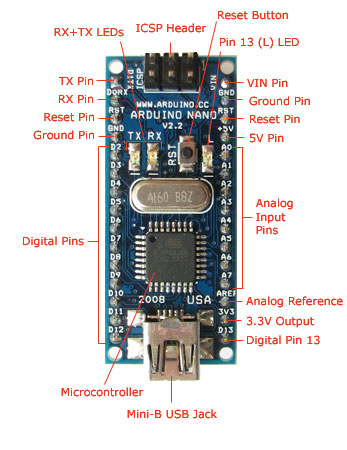 |
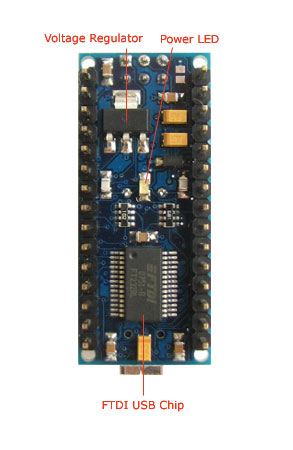 |
Schematic and Design
Arduino Nano 3.0 (ATmega328): schematic, Eagle files. Operating Voltage (logic level)5 VInput Voltage (recommended)7-12 VInput Voltage (limits)6-20 VDigital I/O Pins14 (of which 6 provide PWM output)Analog Input Pins8DC Current per I/O Pin40 mAFlash Memory16 KB (ATmega168) or 32 KB (ATmega328) of which 2 KB used by bootloaderSRAM1 KB (ATmega168) or 2 KB (ATmega328)EEPROM512 bytes (ATmega168) or 1 KB (ATmega328)Clock Speed16 MHzDimensions0.73″ x 1.70″Arduino Original Proto Shield
The Arduino Prototyping Shield makes it easy for you to design custom circuits. You can solder parts to the prototyping area to create your project, or use it with a small solderless breadboard (not included) to quickly test circuit ideas without having to solder. It’s got extra connections for all of the Arduino I/O pins, and it’s got space to mount through-hole and surface mount integrated circuits. It’s a convenient way to make your custom circuit and Arduino into a single module.
Summary
A wide prototyping area with some extra features:| 1.0 | Arduino pinout |
| 1 | Reset button |
| 1 | ICSP connector |
| 14 | pin SMD footprint (50 mils pitch) |
| 20 | pin Through Hole footprint (100 mils pitch) |
Schematic & Reference Design
EAGLE files: arduino_ProtoShield_Rev3.zip Schematic: arduino_ProtoShield_Rev3-schematic.pdfPower
The Proto Shield bring the power from the Arduino standard 5V and GND pins to the two power bus rows placed between the Through Hole package footprint, which can be used for powering the DIP sockets, or for power and ground rows.SPI connection
The ICSP connector available on the shield hove his connections made directly to the SPI pins.- 1: (the one with the smal pointer sign) MISO connected to D12
- 2: +5V
- 3: SCK connected to D13
- 4: MOSI connected to D11
- 5: SS connected to D10
- 6: GND
Physical Characteristics
The maximum length and width of the Proto Shield PCB are 2.7 and 2.1 inches respectively. Three screw holes allow the shield to be attached to a surface or case. Note that the distance between digital pins 7 and 8 is 160 mil (0.16″), not an even multiple of the 100 mil spacing of the other pins.Arduino Original Uno R3
The Arduino Uno is a microcontroller board based on the ATmega328 (datasheet). It has 14 digital input/output pins (of which 6 can be used as PWM outputs), 6 analog inputs, a 16 MHz ceramic resonator, a USB connection, a power jack, an ICSP header, and a reset button. It contains everything needed to support the microcontroller; simply connect it to a computer with a USB cable or power it with a AC-to-DC adapter or battery to get started.
The Uno differs from all preceding boards in that it does not use the FTDI USB-to-serial driver chip. Instead, it features the Atmega16U2 (Atmega8U2 up to version R2) programmed as a USB-to-serial converter. Revision 2 of the Uno board has a resistor pulling the 8U2 HWB line to ground, making it easier to put into . Revision 3 of the board has the following new features:
- 1.0 pinout: added SDA and SCL pins that are near to the AREF pin and two other new pins placed near to the RESET pin, the IOREF that allow the shields to adapt to the voltage provided from the board. In future, shields will be compatible both with the board that use the AVR, which operate with 5V and with the Arduino Due that operate with 3.3V. The second one is a not connected pin, that is reserved for future purposes.
- Stronger RESET circuit.
- Atmega 16U2 replace the 8U2.
Summary
| Microcontroller | ATmega328 |
| Operating Voltage | 5V |
| Input Voltage (recommended) | 7-12V |
| Input Voltage (limits) | 6-20V |
| Digital I/O Pins | 14 (of which 6 provide PWM output) |
| Analog Input Pins | 6 |
| DC Current per I/O Pin | 40 mA |
| DC Current for 3.3V Pin | 50 mA |
| Flash Memory | 32 KB (ATmega328) of which 0.5 KB used by bootloader |
| SRAM | 2 KB (ATmega328) |
| EEPROM | 1 KB (ATmega328) |
| Clock Speed | 16 MHz |
Arduino Original Uno SMD Rev3
The Arduino Uno SMD R3 is a microcontroller board based on the ATmega328 (datasheet). It has 14 digital input/output pins (of which 6 can be used as PWM outputs), 6 analog inputs, a 16 MHz crystal oscillator, a USB connection, a power jack, an ICSP header, and a reset button. It contains everything needed to support the microcontroller; simply connect it to a computer with a USB cable or power it with a AC-to-DC adapter or battery to get started.
The Uno differs from all preceding boards in that it does not use the FTDI USB-to-serial driver chip.
If you want to give a closer look to this board we advice you to visit the official Arduino UNO page in the Hardware Section.
Additional features coming with the R3 version are:
- ATmega16U2 instead 8U2 as USB-to-Serial converter.
- 1.0 pinout: added SDA and SCL pins for TWI communication placed near to the AREF pin and two other new pins placed near to the RESET pin, the IOREF that allow the shields to adapt to the voltage provided from the board and the second one is a not connected pin, that is reserved for future purposes.
- stronger RESET circuit.
Technical Specifications
| Microcontroller | ATmega328 |
| Operating Voltage | 5V |
| Supply Voltage (recommended) | 7-12V |
| Maximum supply voltage (not recommended) | 20V |
| Digital I/O Pins | 14 (of which 6 provide PWM output) |
| Analog Input Pins | 6 |
| DC Current per I/O Pin | 40 mA |
| DC Current for 3.3V Pin | 50 mA |
| Flash Memory | 32 KB (ATmega328) of which 0.5 KB used by bootloader |
| SRAM | 2 KB (ATmega328) |
| EEPROM | 1 KB (ATmega328) |
| Clock Speed | 16 MHz |
Arduino Original USB 2 Serial Converter
This board converts a USB connection into 5 volt TX and RX that you can connect straight to the Arduino Ethernet or any other boards with an FTDI cable-compatible connector.
It features the Atmega8U2 programmed as a USB-to-serial converter, the same chip found on the Arduino Uno. The USB Serial module has an ISCP interface, allowing you to reprogram the chip when placed in DFU mode.
The pinouts on the connector are compatible with a standard FTDI header (as well as the Adafruit and Sparkfun USB-Serial adapters).
Arduino Robot
El Arduino Robot es la primera Arduino oficial sobre ruedas. El robot tiene dos procesadores, uno en cada uno de sus dos tableros. El motor board controla los motores y el Control Board lee sensores y decide cómo operar. Cada una de las tablas es una placa Arduino completa programable utilizando el IDE Arduino.
Tanto el motor y tableros de control son placas de microcontroladores basados en el ATMEGA32U4 (hoja de datos). El robot tiene muchos de sus pines asignados a los sensores de a bordo y actuadores.
La programación del robot es similar al proceso con el Arduino Leonardo. Ambos procesadores han incorporado en comunicación USB, eliminando la necesidad de un procesador secundario. Esto permite que el robot que aparezca como un ordenador conectado como un puerto serie/COM virtual (CDC).
Como siempre con Arduino, todos los elementos de la plataforma – hardware, software y documentación – es de libre acceso y de código abierto. Esto significa que usted puede aprender exactamente cómo se hace y utilizar su diseño como punto de partida para sus propios robots. El Arduino Robot es el resultado del esfuerzo colectivo de un equipo internacional que mira cómo la ciencia puede ser divertida de aprender. Arduino está ahora sobre ruedas y viene paseo con nosotros!
vía Arduino – Robot.
Control Board Summary
| Microcontroller | ATmega32u4 |
| Operating Voltage | 5V |
| Input Voltage | 5V through flat cable |
| Digital I/O Pins | 5 |
| PWM Channels | 6 |
| Analog Input Channels | 4 (of the Digital I/O pins) |
| Analog Input Channels (multiplexed) | 8 |
| DC Current per I/O Pin | 40 mA |
| Flash Memory | 32 KB (ATmega32u4) of which 4 KB used by bootloader |
| SRAM | 2.5 KB (ATmega32u4) |
| EEPROM (internal) | 1 KB (ATmega32u4) |
| EEPROM (external) | 512 Kbit (I2C) |
| Clock Speed | 16 MHz |
| Keypad | 5 keys |
| Knob | potentiomenter attached to analog pin |
| Full color LCD | over SPI communication |
| SD card reader | for FAT16 formatted cards |
| Speaker | 8 Ohm |
| Digital Compass | provides deviation from the geographical north in degrees |
| I2C soldering ports | 3 |
| Prototyping areas | 4 |
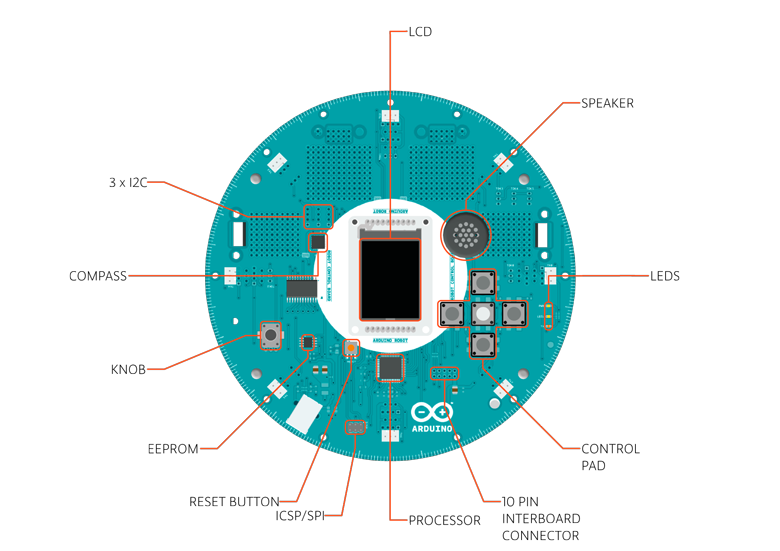
Motor Board Summary
| Microcontroller | ATmega32u4 |
| Operating Voltage | 5V |
| Input Voltage | 9V to battery charger |
| AA battery slot | 4 alkaline or NiMh rechargeable batteries |
| Digital I/O Pins | 4 |
| PWM Channels | 1 |
| Analog Input Channles | 4 (same as the Digital I/O pins) |
| DC Current per I/O Pin | 40 mA |
| DC-DC converter | generates 5V to power up the whole robot |
| Flash Memory | 32 KB (ATmega32u4) of which 4 KB used by bootloader |
| SRAM | 2.5 KB (ATmega32u4) |
| EEPROM | 1 KB (ATmega32u4) |
| Clock Speed | 16 MHz |
| Trimmer | for movement calibration |
| IR line following sensors | 5 |
| I2C soldering ports | 1 |
| Prototyping areas | 2 |

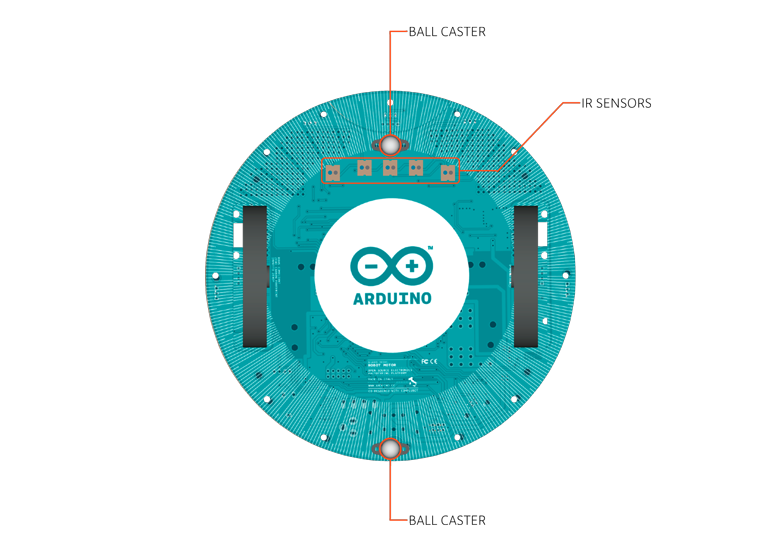
Schematic & Reference Design
EAGLE files for control and motor boards: arduino-robot-reference-design.zipPower
The Arduino Robot can be powered via the USB connection or with 4 AA batteries. The power source is selected automatically. The battery holder holds 4 rechargeable NiMh AA batteries. NB : Do not use non-rechargeable batteries with the robot For safety purposes, the motors are disabled when the robot is powered from the USB connection. The robot has an on-board battery charger that requires 9V external power coming from an AC-to-DC adapter (wall-wart). The adapter can be connected by plugging a 2.1mm center-positive plug into the Motor Board’s power jack. The charger will not operate if powered by USB. The Control Board is powered by the power supply on the Motor Board.Memory
The ATmega32u4 has 32 KB (with 4 KB used for the bootloader). It also has 2.5 KB of SRAM and 1 KB of EEPROM (which can be read and written with the EEPROM library). The Control Board has an extra 512 Kbit EEPROM that can be accessed via I2C. There is an external SD card reader attached to the GTFT screen that can be accessed by the Control Board’s processor for additional storage.Input and Output
The Robot comes with a series of pre-soldered connectors. There are a number of additional spots for you to install additional parts if needed. All the connectors are labelled on the boards and mapped to named ports through the Robot library allowing access to standard Arduino functions. Each pin can provide or receive a maximum of 40mA at 5V. Some pins have specialized functions :- Control Board TK0 to TK7: these pins are multiplexed to a single analog pin on theControl Board’s microprocessor. They can be used as analog inputs for sensors like distance sensors, analog ultrasound sensors, or mechanical switches to detect collisions.
- Control Board TKD0 to TKD5: these are digital I/O pins directly connected to the processor, addressed usingRobot.digitalRead() and Robot.digitalWrite) functions. Pins TKD0 to TKD3 can also be used as analog inputs withRobot.analogRead() Note: if you have one of the first generation robots, you will see that the TKD* pins are named TDK* on the Robot’s silkscreen. TKD* is the proper name for them and is how we address them on the software.
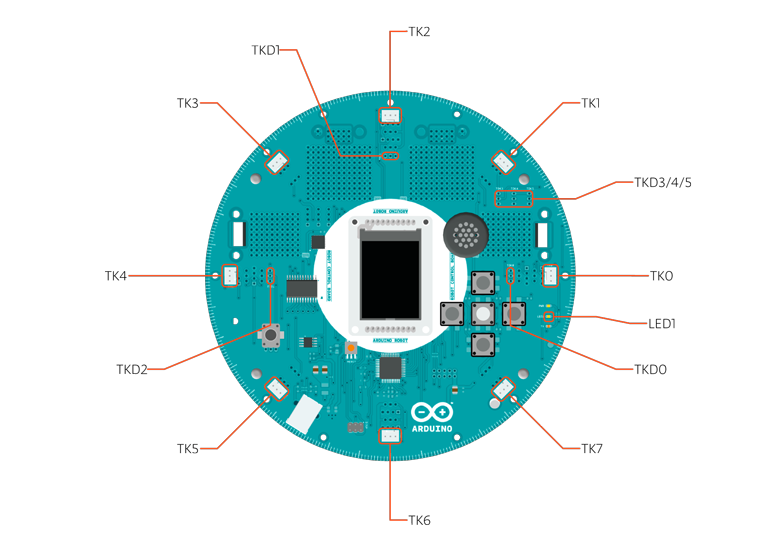
- Motor Board TK1 to TK4: these pins are named in software as B_TK1 to B_TK4, they can be digital or analog input pins, and support Robot.digitalRead(), Robot.digitalWrite) and Robot.analogRead().

- Serial Communication: The boards communicate with each other using the processors’ serial port. A 10-pin connector connects both boards carries the serial communication, as well as power and additional information like the battery’s current charge.
- Control Board SPI: SPI is used to control the GTFT and SD card. If you want to flash the processor using an external programmer, you need to disconnect the screen first
- Control Board LEDs: the Control Board has three on-board LEDs. One indicates the board is powered (PWR). The other two indicate communication over the USB port (LED1/RX and TX). LED1 is also accessible via software.
- Both boards have I2C connectors available: 3 on the Control Board and 1 on the Motor Board.
Control Board Pin Mapping
| ARDUINO LEONARDO | ARDUINO ROBOT CONTROL | ATMEGA 32U4 | FUNCTION | REGISTER |
| D0 | RX | PD2 | RX | RXD1/INT2 |
| D1 | TX | PD3 | TX | TXD1/INT3 |
| D2 | SDA | PD1 | SDA | SDA/INT1 |
| D3# | SCL | PD0 | PWM8/SCL | OC0B/SCL/INT0 |
| D4 | MUX_IN A6 | PD4 | ADC8 | |
| D5# | BUZZ | PC6 | ??? | OC3A/#OC4A |
| D6# | MUXA/TKD4 A7 | PD7 | FastPWM | #OC4D/ADC10 |
| D7 | RST_LCD | PE6 | INT6/AIN0 | |
| D8 | CARD_CS A8 | PB4 | ADC11/PCINT4 | |
| D9# | LCD_CS A9 | PB5 | PWM16 | OC1A/#OC4B/ADC12/PCINT5 |
| D10# | DC_LCD A10 | PB6 | PWM16 | OC1B/0c4B/ADC13/PCINT6 |
| D11# | MUXB | PB7 | PWM8/16 | 0C0A/OC1C/#RTS/PCINT7 |
| D12 | MUXC/TKD5 A11 | PD6 | T1/#OC4D/ADC9 | |
| D13# | MUXD | PC7 | PWM10 | CLK0/OC4A |
| A0 | KEY D18 | PF7 | ADC7 | |
| A1 | TKD0 D19 | PF6 | ADC6 | |
| A2 | TKD1 D20 | PF5 | ADC5 | |
| A3 | TKD2 D21 | PF4 | ADC4 | |
| A4 | TKD3 D22 | PF1 | ADC1 | |
| A5 | POT D23 | PF0 | ADC0 | |
| MISO | MISO D14 | PB3 | MISO,PCINT3 | |
| SCK | SCK D15 | PB1 | SCK,PCINT1 | |
| MOSI | MOSI D16 | PB2 | MOSI,PCINT2 | |
| SS | RX_LED D17 | PB0 | RXLED,SS/PCINT0 | |
| TXLED | TX_LED | PD5 | ||
| HWB | PE2 | HWB |
Motor Board Pin Mapping
| ARDUINO LEONARDO | ARDUINO ROBOT CONTROL | ATMEGA 32U4 | FUNCTION | REGISTER |
| D0 | RX | PD2 | RX | RXD1/INT2 |
| D1 | TX | PD3 | TX | TXD1/INT3 |
| D2 | SDA | PD1 | SDA | SDA/INT1 |
| D3# | SCL | PD0 | PWM8/SCL | OC0B/SCL/INT0 |
| D4 | TK3 A6 | PD4 | ADC8 | |
| D5# | INA2 | PC6 | ??? | OC3A/#OC4A |
| D6# | INA1 A7 | PD7 | FastPWM | #OC4D/ADC10 |
| D7 | MUXA | PE6 | INT6/AIN0 | |
| D8 | MUXB A8 | PB4 | ADC11/PCINT4 | |
| D9# | INB2 A9 | PB5 | PWM16 | OC1A/#OC4B/ADC12/PCINT5 |
| D10# | INB1 A10 | PB6 | PWM16 | OC1B/0c4B/ADC13/PCINT6 |
| D11# | MUXC | PB7 | PWM8/16 | 0C0A/OC1C/#RTS/PCINT7 |
| D12 | TK4 A11 | PD6 | T1/#OC4D/ADC9 | |
| D13# | MUXI | PC7 | PWM10 | CLK0/OC4A |
| A0 | TK1 D18 | PF7 | ADC7 | |
| A1 | TK2 D19 | PF6 | ADC6 | |
| A2 | MUX_IN D20 | PF5 | ADC5 | |
| A3 | TRIM D21 | PF4 | ADC4 | |
| A4 | SENSE_A D22 | PF1 | ADC1 | |
| A5 | SENSE_B D23 | PF0 | ADC0 | |
| MISO | MISO D14 | PB3 | MISO,PCINT3 | |
| SCK | SCK D15 | PB1 | SCK,PCINT1 | |
| MOSI | MOSI D16 | PB2 | MOSI,PCINT2 | |
| SS | RX_LED D17 | PB0 | RXLED,SS/PCINT0 | |
| TXLED | TX_LED | PD5 | ||
| HWB | PE2 | HWB |
Communication
The Robot has a number of facilities for communicating with a computer, another Arduino, or other microcontrollers. TheATmega32U4 provides UART TTL (5V) serial communication, which is available on digital the 10-pin board-to-board connector. The 32U4 also allows for serial (CDC) communication over USB and appears as a virtual com port to software on the computer. The chip also acts as a full speed USB 2.0 device, using standard USB COM drivers. On Windows, a .inf file is required. The Arduino software includes a serial monitor which allows simple textual data to be sent to and from the Robot board. The RX (LED1) and TX LEDs on the board will flash when data is being transmitted via the USB connection to the computer (but not for serial communication between boards). Each one of the boards has a separate USB product identifier and will show up as different ports on you IDE. Make sure you choose the right one when programming. The ATmega32U4 also supports I2C (TWI) and SPI communication. The Arduino software includes a Wire library to simplify use of the I2C bus; see the documentation for details. For SPI communication, use the SPI library.Programming
The Robot can be programmed with the Arduino software (download). Select «Arduino Robot Control Board» or «Arduino Robot Motor Board» from the Tools > Board menu. For details, see the getting started page and tutorials. The ATmega32U4 processors on the Arduino Robot come preburned with a bootloader that allows you to upload new code to it without the use of an external hardware programmer. It communicates using the AVR109 protocol. You can bypass the bootloader and program the microcontroller through the ICSP (In-Circuit Serial Programming) header; see these instructions for details.Automatic (Software) Reset and Bootloader Initiation
Rather than requiring a physical press of the reset button before an upload, the Robot is designed in a way that allows it to be reset by software running on a connected computer. The reset is triggered when the Robot’s virtual (CDC) serial / COM port is opened at 1200 baud and then closed. When this happens, the processor will reset, breaking the USB connection to the computer (meaning that the virtual serial / COM port will disappear). After the processor resets, the bootloader starts, remaining active for about 8 seconds. The bootloader can also be initiated by double-pressing the reset button on the Robot. Note that when the board first powers up, it will jump straight to the user sketch, if present, rather than initiating the bootloader. Because of the way the Robot handles reset it’s best to let the Arduino software try to initiate the reset before uploading, especially if you are in the habit of pressing the reset button before uploading on other boards. If the software can’t reset the board you can always start the bootloader by double-pressing the reset button on the board. A single press on the reset will restart the user sketch, a double press will initiate the bootloader.USB Overcurrent Protection
Both of the Robot boards have a resettable polyfuse that protects your computer’s USB ports from shorts and overcurrent. Although most computers provide their own internal protection, the fuse provides an extra layer of protection. If more than 500 mA is applied to the USB port, the fuse will automatically break the connection until the short or overload is removed.Physical Characteristics
The Robot is 19cm in diameter. Including wheels, GTFT screen and other connectors it can be up to 10cm tall.To Learn More
See also: getting started with the Arduino Robot and the Robot’s library pages.Arduino Shield 40pcs×20cm female to female Dupont cables
- 40P color dupont line
- length:20cm
- 1p-1p female to female pin header
- a row including of 40 root
- Compatible with 2.54mm spacing pin headers
Arduino Shield 40pcs×20cm male to female Dupont cables
- 40P color dupont line
- length:20cm
- 1p-1p male to female pin header
- a row including of 40 root
- Compatible with 2.54mm spacing pin headers
Arduino YÚN
Overview
The Arduino Yún is a microcontroller board based on the ATmega32u4 (datasheet) and the Atheros AR9331. The Atheros processor supports a Linux distribution based on OpenWRT named Linino. The board has built-in Ethernet and WiFisupport, a USB-A port, micro-SD card slot, 20 digital input/output pins (of which 7 can be used as PWM outputs and 12 as analog inputs), a 16 MHz crystal oscillator, a micro USB connection, an ICSP header, and a 3 reset buttons.

The Yún distinguishes itself from other Arduino boards in that it can communicate with the Linux distribution onboard, offering a powerful networked computer with the ease of Arduino. In addition to Linux commands like cURL, you can write your own shell and python scripts for robust interactions.
The Yún is similar to the Leonardo in that the ATmega32u4 has built-in USB communication, eliminating the need for a secondary processor. This allows the Yún to appear to a connected computer as a mouse and keyboard, in addition to a virtual (CDC) serial / COM port.
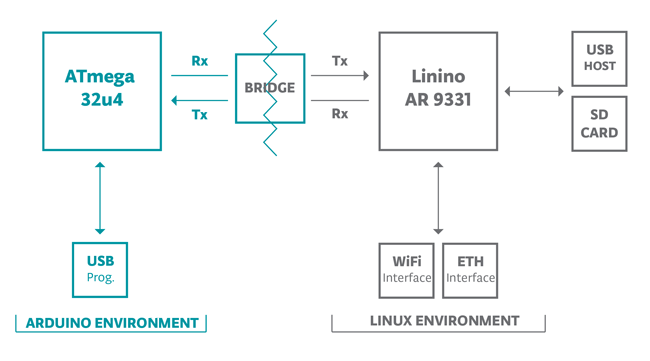
The Bridge library facilitates communication between the two processors, giving Arduino sketches the ability to run shell scripts, communicate with network interfaces, and receive information from the AR9331 processor. The USB host, network interfaces and SD card are not connected to the 32U4, but the AR9331, and the Bridge library also enables the Arduino to interface with those peripherals.
Summary
Because the Yún has two processors, the summary section shows the characteristics of each one in two separate tables.| AVR Arduino microcontroller | |
| Microcontroller | ATmega32u4 |
| Operating Voltage | 5V |
| Input Voltage | 5V |
| Digital I/O Pins | 20 |
| PWM Channels | 7 |
| Analog Input Channels | 12 |
| DC Current per I/O Pin | 40 mA |
| DC Current for 3.3V Pin | 50 mA |
| Flash Memory | 32 KB (of which 4 KB used by bootloader) |
| SRAM | 2.5 KB |
| EEPROM | 1 KB |
| Clock Speed | 16 MHz |
| Linux microprocessor | |
| Processor | Atheros AR9331 |
| Architecture | MIPS @400MHz |
| Operating Voltage | 3.3V |
| Ethernet | IEEE 802.3 10/100Mbit/s |
| WiFi | IEEE 802.11b/g/n |
| USB Type-A | 2.0 Host/Device |
| Card Reader | Micro-SD only |
| RAM | 64 MB DDR2 |
| Flash Memory | 32 MB |
| PoE compatible 802.3af card support |
Schematic & Reference Design
Schematic: arduino-Yun-schematic.pdfPower
It is recommended to power the board via the micro-USB connection with 5VDC.
If you are powering the board though the Vin pin, you must supply a regulated 5VDC. There is no on-board voltage regulator for higher voltages, which will damage the board.
The Yún is also compatible with PoE power supply but in order to use this feature you need to mount a PoE module on the board or buy a preassembled one.
The power pins are as follows:
- VIN. The input voltage to the Arduino board. Unlike other Arduino boards, if you are going to provide power to the board through this pin, you must provide a regulated 5V.
- 5V. The power supply used to power the microcontrollers and other components on the board. This can come either from VIN or be supplied by USB.
- 3V3. A 3.3 volt supply generated by the on-board regulator. Maximum current draw is 50 mA.
- GND. Ground pins.
- IOREF. The voltage at which the i/o pins of the board are operating (i.e. VCC for the board). This is 5V on the Yún.
Memory
The ATmega32u4 has 32 KB (with 4 KB used for the bootloader). It also has 2.5 KB of SRAM and 1 KB of EEPROM (which can be read and written with the EEPROM library).
The memory on the AR9331 is not embedded inside the processor. The RAM and the storage memory are externally connected. The Yún has 64 MB of DDR2 RAM and 16 MB of flash memory. The flash memory is preloaded in factory with a Linux distribution based on OpenWRT called Linino. You can change the content of the factory image, such as when you install a program or when you change a configuration file. You can return to the factory configuration by pressing the «WLAN RST» button for 30 seconds.
Input and Output
It is not possible to access the I/O pins of the Atheros AR9331. All I/O lines are tied to the 32U4.
Each of the 20 digital i/o pins on the Yún can be used as an input or output, using pinMode(), digitalWrite(), anddigitalRead() functions. They operate at 5 volts. Each pin can provide or receive a maximum of 40 mA and has an internal pull-up resistor (disconnected by default) of 20-50 kOhms. In addition, some pins have specialized functions:
- Serial: 0 (RX) and 1 (TX). Used to receive (RX) and transmit (TX) TTL serial data using the ATmega32U4 hardware serial capability. Note that on the Yún, the Serial class refers to USB (CDC) communication; for TTL serial on pins 0 and 1, use the Serial1 class. The hardware serials of the ATmega32U4 and the AR9331 on the Yún are connected together and are used to communicate between the two processors. As is common in Linux systems, on the serial port of the AR9331 is exposed the console for access to the system, this means that you can access to the programs and tools offered by Linux from your sketch.
- TWI: 2 (SDA) and 3 (SCL). Support TWI communication using the Wire library.
- External Interrupts: 3 (interrupt 0), 2 (interrupt 1), 0 (interrupt 2), 1 (interrupt 3) and 7 (interrupt 4). These pins can be configured to trigger an interrupt on a low value, a rising or falling edge, or a change in value. See the attachInterrupt() function for details. Is not recommended to use pins 0 and 1 as interrupts because they are the also the hardware serial port used to talk with the Linux processor. Pin 7 is connected to the AR9331 processor and it may be used as handshake signal in future. Is recommended to be careful of possible conflicts if you intend to use it as interrupt.
- PWM: 3, 5, 6, 9, 10, 11, and 13. Provide 8-bit PWM output with the analogWrite() function.
- SPI: on the ICSP header. These pins support SPI communication using the SPI library. Note that the SPI pins are not connected to any of the digital I/O pins as they are on the Uno, They are only available on the ICSP connector. This means that if you have a shield that uses SPI, but does NOT have a 6-pin ICSP connector that connects to the Yún’s 6-pin ICSP header, the shield will not work.
The SPI pins are also connected to the AR9331 gpio pins, where it has been implemented in software the SPI interface. This means that the ATMega32u4 and the AR9331 can also communicate using the SPI protocol.
- LED: 13. There is a built-in LED connected to digital pin 13. When the pin is HIGH value, the LED is on, when the pin is LOW, it’s off.
- There are several other status LEDs on the Yún, indicating power, WLAN connection, WAN connection and USB.
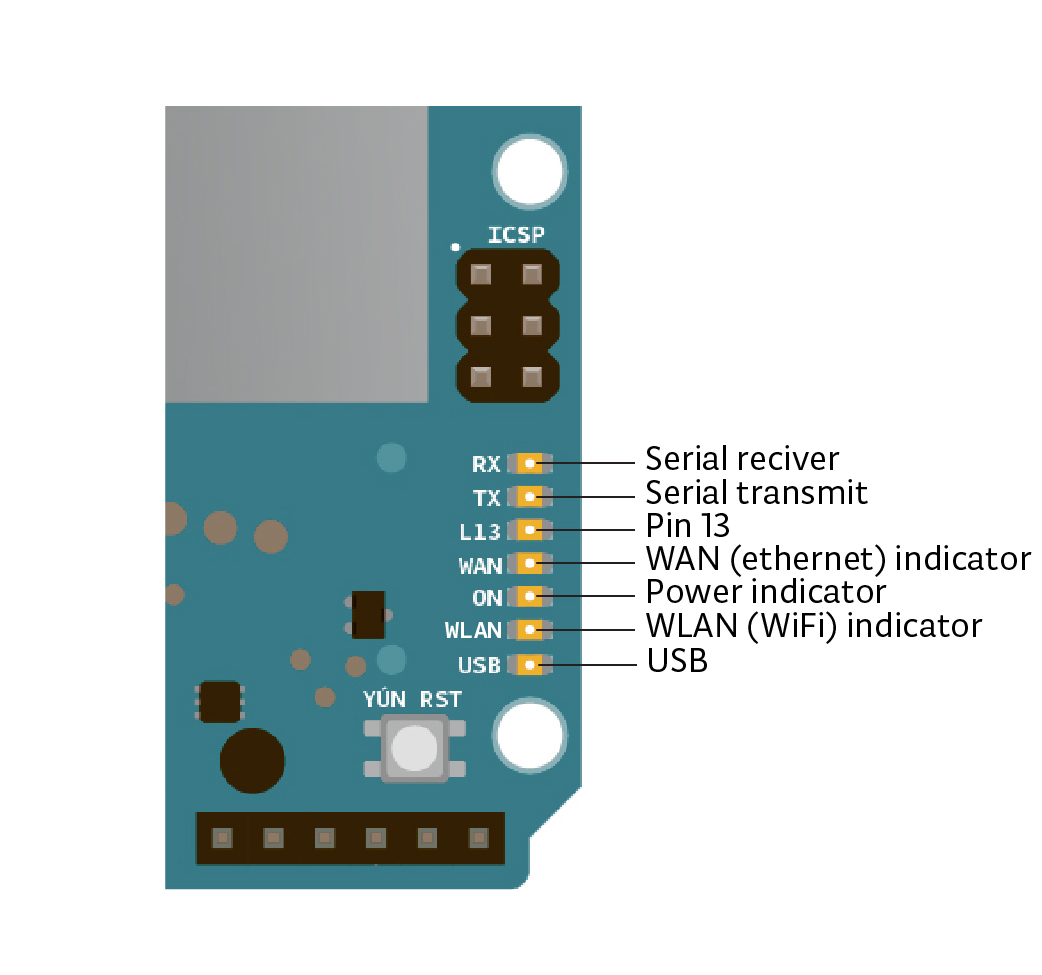
- Analog Inputs: A0 – A5, A6 – A11 (on digital pins 4, 6, 8, 9, 10, and 12). The Yún has 12 analog inputs, labeled A0 through A11, all of which can also be used as digital i/o. Pins A0-A5 appear in the same locations as on the Uno; inputs A6-A11 are on digital i/o pins 4, 6, 8, 9, 10, and 12 respectively. Each analog input provide 10 bits of resolution (i.e. 1024 different values). By default the analog inputs measure from ground to 5 volts, though is it possible to change the upper end of their range using the AREF pin and the analogReference() function.
- AREF. Reference voltage for the analog inputs. Used with analogReference().
There are 3 reset buttons with different functions on the board:
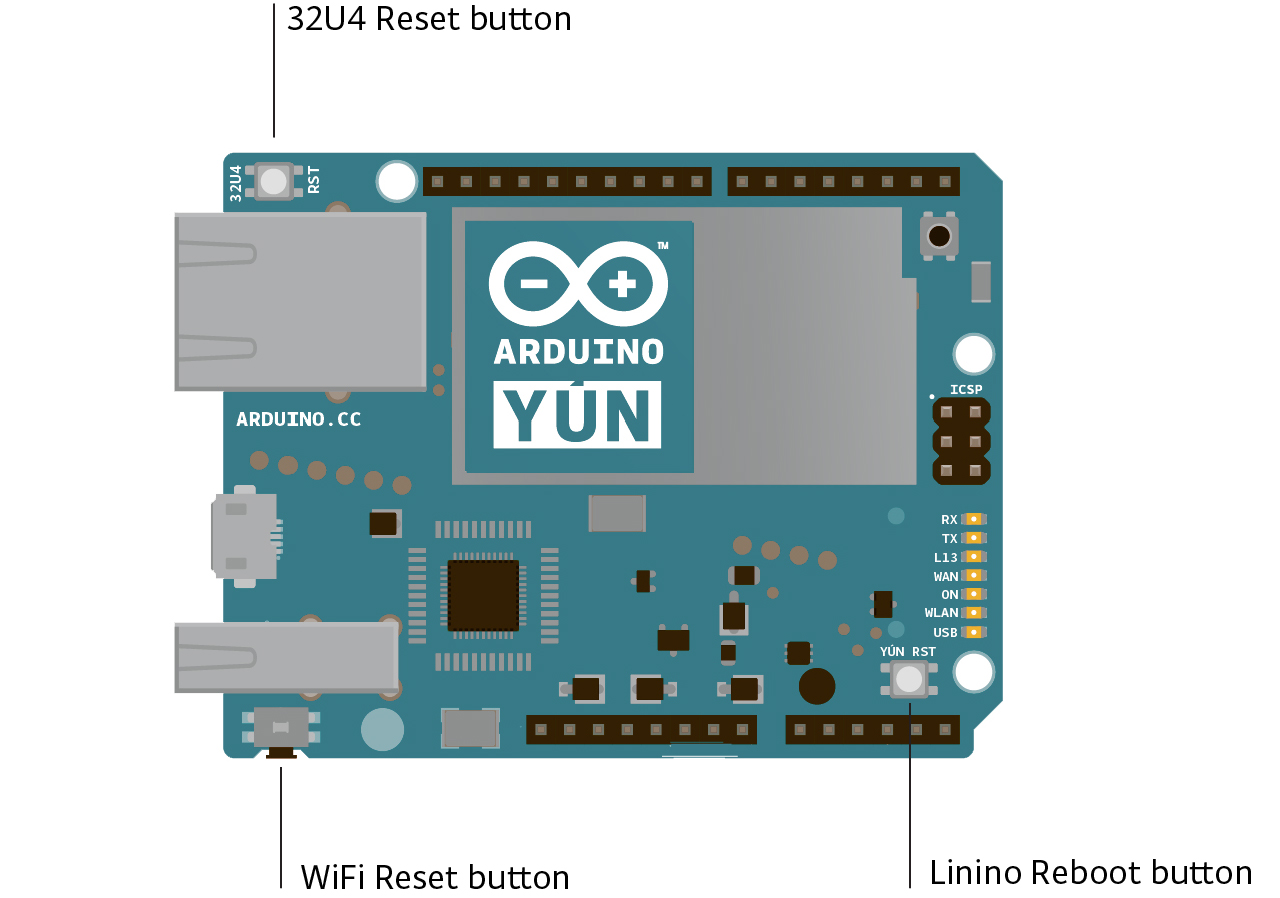
- Yún RST. Bring this line LOW to reset the AR9331 microprocessor. Resetting the AR9331 will cause the reboot of the linux system. All the data stored in RAM will be lost and all the programs that are running will be terminated.
- 32U4 RST. Bring this line LOW to reset the ATmega32U4 microcontroller. Typically used to add a reset button to shields which block the one on the board.
- WLAN RST. This button has a double feature. Primarly serves to restore the WiFi to the factory configuration. The factory configuration consist to put the WiFi of the Yún in access point mode (AP) and assign to it the default IP address that is 192.168.240.1, in this condition you can connect with your computer to the a WiFi network that appear with the SSID name «Arduino Yun-XXXXXXXXXXXX», where the twelve ‘X’ are the MAC address of your Yún. Once connected you can reach the web panel of the Yún with a browser at the 192.168.240.1 or «http://arduino.local» address. Note that restoring the WiFi configuration will cause the reboot of the linux environment. To restore your WiFi configuration you have to press and hold the WLAN RST button for 5 seconds. When you press the button the WLAN blue LED will start to blink and will keep still blinking when you release the button after 5 seconds indicating that the WiFi restore procedure has been recorded. The second function of the WLAN RST button is torestore the linux image to the default factory image. To restore the linux environment you must press the button for 30 seconds. Note that restoring the factory image make you lose all the files saved and softwares installed on the on-board flash memory connected to the AR9331.
See also the mapping between Arduino pins and ATmega32u4 ports.
Communication
The Yún has a number of facilities for communicating with a computer, another Arduino, or other microcontrollers. TheATmega32U4 provides a dedicated UART TTL (5V) serial communication. The 32U4 also allows for serial (CDC) communication over USB and appears as a virtual com port to software on the computer. The chip also acts as a full speed USB 2.0 device, using standard USB COM drivers. The Arduino software includes a serial monitor which allows simple textual data to be sent to and from the Arduino board. The RX and TX LEDs on the board will flash when data is being transmitted via the USB connection to the computer.
Digital pins 0 and 1 are used for serial communication between the 32U4 and the AR9331. Communication between the processors is handled by the Bridge library.
A SoftwareSerial library allows for serial communication on any of the Yún’s digital pins except for pins 0 and 1.
The ATmega32U4 also supports I2C (TWI) and SPI communication. The Arduino software includes a Wire library to simplify use of the I2C bus; see the documentation for details. For SPI communication, use the SPI library.
The Yún appears as a generic keyboard and mouse, and can be programmed to control these input devices using theKeyboard and Mouse classes.
The onboard Ethernet and WiFi interfaces are exposed directly to the AR9331 processor. To send and receive data through them, use the Bridge library. To configure the interfaces, you can access the network control panel as described in thegetting started page.
The Yún also has USB host capabilities through Linino. You can connect peripherals like USB flash devices for additional storage, keyboards, or webcams. You may need to download and install additional software for these devices to work. For information on adding software to the AR9331, refer to the notes on using the package manager.
Programming
The Yún can be programmed with the Arduino software (download). Select «Arduino Yún from the Tools > Board menu (according to the microcontroller on your board). For details, see the reference and tutorials.
The ATmega32U4 on the Arduino Yún comes preburned with a bootloader that allows you to upload new code to it without the use of an external hardware programmer. It communicates using the AVR109 protocol.
You can also bypass the bootloader and program the microcontroller through the ICSP (In-Circuit Serial Programming) header; see these instructions for details.
Automatic (Software) Reset and Bootloader Initiation
Rather than requiring a physical press of the reset button before an upload, the Yún is designed in a way that allows it to be reset by software running on a connected computer. The reset is triggered when the Yún’s virtual (CDC) serial / COM port is opened at 1200 baud and then closed. When this happens, the processor will reset, breaking the USB connection to the computer (meaning that the virtual serial / COM port will disappear). After the processor resets, the bootloader starts, remaining active for about 8 seconds. The bootloader can also be initiated by pressing the reset button on the Yún. Note that when the board first powers up, it will jump straight to the user sketch, if present, rather than initiating the bootloader.
Because of the way the Yún handles reset it’s best to let the Arduino software try to initiate the reset before uploading, especially if you are in the habit of pressing the reset button before uploading on other boards. If the software can’t reset the board you can always start the bootloader by pressing the reset button on the board.
USB Overcurrent Protection
The Yún has a resettable polyfuse that protects your computer’s USB ports from shorts and overcurrent. Although most computers provide their own internal protection, the fuse provides an extra layer of protection. If more than 500 mA is applied to the USB port, the fuse will automatically break the connection until the short or overload is removed.
Physical Characteristics
The maximum length and width of the Yún PCB are 2.7 and 2.1 inches respectively, with the USB connector extending beyond the former dimension. Four screw holes allow the board to be attached to a surface or case. Note that the distance between digital pins 7 and 8 is 160 mil (0.16″), not an even multiple of the 100 mil spacing of the other pins.
Using your Yun
There is an extensive Getting Started Guide and a number of tutorials found on the library reference page.
Breadboard Power Supply Module 3.3V/5V For Arduino Board
Fuente de alimentación para conectar directamente en el Breadboard, compatible con circuitos de 5V y 3.3 V
- Apply to MB102 breadboard
- Input voltage: 6.5-12 V (DC) or USB power supply
- Output voltage: 3.3V/5V can switch over
- Maximum output current: Fluctuation two road independent control, can switch over to 0 V, 3.3 V, 5 V
- On-board two groups of 3.3V, 5V DC output plug pin, convenient external lead use.
Aviso: Sólo incluye la fuente de alimentación, el Breadboard no está incluido.
Camera Platform Anti-Vibration Camera Mount (sin servos)
- Two axies platform 20g
- suitable for 9g-12g servos, precision and great appearance, without shaking, with clamp for servo wire.
- Camera and Servos is not included.
Camera mount and screws only
Notes: need cut some fim of servos for assemble
Cómo montar el kit.
Camera Platform Anti-Vibration Camera Mount incluye 2 servos SG90s
- Two axies platform 20g
- Incluye 2x 9g-servos, precision and great appearance, without shaking, with clamp for servo wire.
- Servos incluidos
Camera mount and screws and 2 servos
Notes: need cut some fim of servos for assemble
Cómo montar el kit.
Character LCD Module Display 2004 204 20X4 For Arduino
The module is a low-power consumption character LCD Module with a built-in controller.
The module can be easily interfaced with a MCU.
Display Format: 20 Characters x 4 lines.
Supply voltage: 5V.
It is fantastic for Arduino based project.
- Fully assembled and tested Serial LCD 20×4 Module.
- White Text, Blue backlight.
- Analog Interface.
- Size:9.8cm x 6cm x 1.2cm – 3.86inch x 2.36inch x 0.47inch.
- Package Included:
- 1 x LCD display module
Digital Humidity & Temperature Sensor DHT1
Relative humidity and temperature measurement
All calibration, digital output, excellent long-time stability without additional components
Ultra-long signal transmission distance, ultra-low energy consumption
4-pin installation
Ethernet Shield W5100 for Arduino UNO Mega 1280 2650
The Compatible Ethernet Shield allows an Arduino board to connect to the internet. It is based on the Wiznet W5100 ethernet chip (datasheet). The Wiznet W5100 provides a network (IP) stack capable of both TCP and UDP. It supports up to four simultaneous socket connections. Use the Ethernet library to write sketches which connect to the internet using the shield. The ethernet shield connects to an Arduino board using long wire-wrap headers which extend through the shield. This keeps the pin layout intact and allows another shield to be stacked on top.
Features
With this Ethernet Shield, your Arduino board can be used to connect to internet. Can be used as server or client. Directly plug puzzle board, no soldering required. Controller: w5100. This is the latest version of the Ethernet Shield. This Arduino Ethernet Shield which is based on the Wiznet W5100 Ethernet Chip gives you an easy way to get your Arduino Online. It is directly supported by Arduino official Ethernet Library. It adds a micro-SD card slot, which can be used to store files for serving over the network. It is compatible with the Arduino Duemilanove (168 or 328), Uno as well as Mega (1280/2560) and can be accessed using the SD library. The Wiznet W5100 provides a network (IP) stack capable of both TCP and UDP. It supports up to four simultaneous socket connections. Use the Ethernet library to write sketches which connect to the internet using the shield. Fits all version of arduino Main board,2009,UNO, mega 1280, mega 2560. Size:7cm x 5.4cm x 2.4cm – 2.76inch x 2.12inch x 0.94inch. MAC address: 0xDE, 0xAD, 0xBE, 0xEF, 0xFE, 0xED byte mac[] = { 0xDE, 0xAD, 0xBE, 0xEF, 0xFE, 0xED };. Package Included: 1 x Ethernet Shield NO Retail Box. Packed Safely in Bubble Bag.Hall switch sensor module Motor speed test
On-board LM393 voltage comparator chip and hall sensing probe, support 5 V / 3.3 V voltage input.
On-board signal output, the output signal is effective instruction low level and at the same time, the output signal lights out can be directly and single-chip microcomputer IO connection.
Signal detection sensitivity can adjust.
Reserve all the way more circuits (P3 voltage drawn).
PCB board size: 30 (mm) x15 (mm)
HC-SR501 New Human Sensor Module Pyroelectric Infrared
- The automatic sensor: to enter the sensor output range is high, people leave the sensor range of the automatic delay off high, output low.
- The photosensitive control (optional, factory is not set) may set the photosensitive control during the day or light intensity without induction.
- The temperature compensation (optional, factory is not set): In the summer when the ambient temperature rises to 30 ~ 32 ℃, slightly shorter detection range, temperature compensation can be used as a performance compensation.
- Two trigger mode: (can be selected by jumpers)
- a, can not repeat the trigger: the sensor output high, the delay time is over, the output will automatically become low from high;
- b, repeatable trigger: the sensor output high after the delay period, if the human body in its sensing range activities, its output will remain high until after the delay will be left high to low (sensor module review Measured activities of each body will be automatically extended after a delay time, and the final event of the delay time Starting point of time).
- With induction blocking time (the default setting: 2.5S block time): sensor module, after each sensor output (high change Into a low level),you can set up a blockade followed by time period, in this time period the sensor does not accept any sensor signal. This feature can have a «sensor output time» and «blocking time» the interval between the work produced can be applied to detect the interval Products; also inhibit this function during load switching for a variety of interference. (This time can be set at zero seconds – Tens of seconds).
- The working voltage range: the default voltage DC4.5V-20V.
- Micro-power consumption: static current «50 microamps, especially for battery-powered automatic control products.
- The output high level signals: types of circuits can be easily and docking.
Instructions
- 1. Sensing module for about a minute after power initialization time, during the interval to the output module 0-3 times a minute in standby mode.
- 2. Should avoid direct lighting such as interference sources close the surface of the lens module so as to avoid the introduction of interference signal generator malfunction; use of the environment to avoid the flow of the wind, the wind sensor will also cause interference.
- 3. Sensor module using a dual probe, the probe’s window is rectangular, dual (A per B million) in the direction of the ends of long, when the body passed from left to right or right to left when the reach the dual IR time, distance difference, the greater the difference, more sensitive sensors, when the body from the front to the probe or from top to bottom or from bottom to top direction passing, dual IR not detected changes in the distance, no difference value, the sensor insensitive or does not work; so the sensors should be installed dual direction of the probe with human activities as much as possible parallel to the direction of maximum to ensure that the body has been passed by the dual sensor probe. To increase the sensing range of angles, the module using a circular lens, the probe also makes sense on all four sides, but still higher than the upper and lower left and right direction of sensing range, sensitivity and strong, still as far as possible by the above installation requirements.VCC, trig (control side), echo (receiving end), GND
Dimensions and Adjustment
Note: The potentiometer clockwise to adjust the distance, sensing range increases (about 7 meters), on the contrary, sensing range decreases (about 3 meters).Delay adjustment potentiometer clockwise rotation, sensor delay longer (about 300S), the other hand, induction by the short delay (about 5S).Applications
- Security Products
- The human body sensors toys
- The human body sensor lighting
- Industrial automation and control, etc.
Electrical parameters
- Product Type: HC–SR501 Body Sensor Module
- Operating voltage range: DC 4.5-20V
- Quiescent Current: <50uA
- Level output: High 3.3 V /Low 0V
- Trigger: L can not be repeated trigger/H can be repeated trigger(Default repeated trigger)
- Delay time: 5-200S(adjustable) the range is (0.xx second to tens of second)
- Block time: 2.5S(default)Can be made a range(0.xx to tens of seconds
- Board Dimensions: 32mm*24mm
- Angle Sensor: Operation Temp: -15-+70 degrees
- Lens size sensor: Diameter:23mm(Default)
Keypad 4×4 matrix keyboard buttons LED Shield
Un modúlo infaltable para nuestras prácticas con microcontroladores, este board tiene:
- Una matriz de 4 x 4 pulsadores.
- Una fila de 4 pulsadores con GND comun y resistencia de 1k a VCC
- Una fila de 8 diodos LED con VCC comun y una resistencia de carga de 1k.
Listo para utilizarlo con nuestros experimentos con Arduino y Raspberry PI
Content
1 pcs ofKeypad 4×4 matrix keyboard buttons LED Shield.
L298N Dual H Bridge DC Stepper Motor Controller for Arduino
L298N is a kind of high voltage,high current motor driver chip produced by ST company.Having 15 pins as package, this chip has such features as high working voltage(maximum voltage up to 46V),large output current(instantaneous peak current up to 3A,continuous working current 2A) and 25W of rated power.Two built-in H birdge high voltage and large current full bridge drivers can be used to drive the DC motor and stepper motor,relay coil and so on.Using standard logic level signal control,it has two enable control ends.It permits or prohibites device having a logic power supply imput without the impact of input signal,which enables the internal logic circuit part works at low voltage.
The chip can connects to external detecting resistor to give the variations to the control circuit.Using L298N chip to drive the motor,this chip can drive a stepping motor or four phase stepping motor, and two DC motors as well.
Descargar liberia para Arduino L298N
Laser Dot Diode Module Head WL Red mini 650nm 6mm 5V 5mW x 2
Laser Dot Diode Module Head WL Red
- Output Power: 5mW, Wavelength: 650nm
- Working Voltage: 5v, Operating Current: less than 40 mA
- Laser Shape: Dot
- Working temperature: -10º~40º
- housing: Copper
- Dimensions: 6.5 X 18 mm
Pack de 2 unidades.
LCD Shield Kit w/16×2 Character Display
LCD Shield Kit w/ 16×2 Character Display – Only 2 pins used!
This is a 16×2 LCD Keypad module for Arduino Diecimila Duemilanove, UNO, MEGA1280, MEGA2560 board.
This shield is perfect for when you want to build a stand-alone project with its own user interface. The 4 directional buttons plus select button allows basic control without having to attach a bulky computer.
Blue Backlight with white words, adjustable backlighting.
4 Bit Arduino LCD Library
The shield is designed for ‘classic’ Arduinos such as the Uno, Duemilanove, Diecimilla, etc. It uses the I2C pins at Analog 4 and Analog 5. It will also work perfectly with Arduino Mega R3’s which have the extra SDA/SCL I2C pins broken out. Earlier Mega’s have the I2C pins in a different location and will require you to solder two wires from the I2C pins on the shield and plug them into the different I2C locations at Digital 20 & 21.
Descargar libreria LCD_Keypad_Shield
Esquema de conexiones (DFRobot LCD Shield) LCD_Keypad_Shield
Manuales de referencia Arduino LCD KeyPad Shield
Librería independiente para manejar displays de 2×16 o 2×20. LCD Display with I2C/TWI Interface
& Updated for the 4 line 20 character
LED RGB Clear Common Cathode x 5
How about an RGB LED? These 5mm units have four pins – Cathode is the longest pin. One for each color and a common cathode. Use this one LED for three status indicators or pulse width modulate all three and get mixed colors!
Features:
- Forward Voltage (RGB): (2.0, 3.2, 3.2)V
- Luminosity (RGB): (800, 4000, 900)mcd
1 Package 5 Pcs
light Sensor Module LM393 for Arduino DO/AO output W Cables 3.3-5V
This module adopts LM393 voltage comparator as the main chip. And it is perfect for light control applications. And onboard power indicator will be turned on when the module is powered by 3.3V – 5V voltage.
Working Voltage: DC 3.3V – 5V
- Sensitivity is adjustable.
- DO and AO outputs.
- PCB Size: 28mm*13mm
Package Contents: 1 x LM393 light Sensor Module
Male to Male Solderless Flexible Breadboard Jumper Cable Wires For Arduino, 65Pc
- 49 pcs 120mm length
- 8 pcs 150mm length
- 4 pcs 200mm length
- 4 pcs 240mm length
- total:65pcs(65pcs/lots)
Male to Male Solderless Flexible Breadboard Jumper Cable Wires For Arduino,65Pc
Motor Drive Shield Expansion Board L293D For Arduino Duemilanove Mega2560 UNO
L293D is a monolithic integrated, high voltage, high current, 4-channel driver,you can use DC motors and power supplies of up to 36 Volts, the L293D chip is alsoknown as a type of H-Bridge,which is typically an electrical circuit that enables a voltage to be applied across a load in either direction to an output, e.g. motor.
- 2 interface for 5V Servo connected to the Arduino’s high-resolution dedicated timer – no jitter.
- Can drive 4 DC motors or 2 stepper motors or 2 Servo.
- Up to 4 bi-directional DC motors with individual 8-bit speed selection.
- Up to 2 stepper motors (unipolar or bipolar) with single coil, double coil or interleaved stepping.
- 4 H-Bridges: per bridge provides 0.6A (1.2A peak current) with thermal protection, can run motors on 4.5V to 36V DC.
- Pull down resistors keep motors disabled during power-up.
- 2 external terminal power interface, for seperate logic/motor supplies.
What pins are not used on the motor shield?
All 6 analog input pins are available. They can also be used as digital pins (pins #14 thru 19) Digital pin 2, and 13 are not used. The following pins are in use only if the DC/Stepper noted is in use:- Digital pin 11: DC Motor #1 / Stepper #1 (activation/speed control)
- Digital pin 3: DC Motor #2 / Stepper #1 (activation/speed control)
- Digital pin 5: DC Motor #3 / Stepper #2 (activation/speed control)
- Digital pin 6: DC Motor #4 / Stepper #2 (activation/speed control)
- Digital pin 4, 7, 8 and 12 are used to drive the DC/Stepper motors via the 74HC595 serial-to-parallel latch
- Digitals pin 9: Servo #1 control
- Digital pin 10: Servo #2 control
MQ-2 MQ2 Smoke Gas + Alcohol Detector Sensor
This Arduino Gas Sensor can detect smoke, methane, carbon dioxide and other gases.It is capable of detecting various gases.This arduino-compatible special sensor raise alarms when the smoke, methane or any other harmful gas leaks in its reach.
- Arduino smoke gas sensor
- Detects smoke, methane, carbon dioxide and other gases
- Gives alarms when the smoke/gas leaks
Type : MQ-2
(Used in homes and factories, gas leakage monitoring devices, suitable for the detection of liquefied petroleum gas, butane, propane, methane, alcohol, hydrogen gas, smoke, etc..)- Gas: smoke
- Detection range: 300 to 10000ppmm
- The characteristics gas: 1000ppmm, isobutane
- Sensitivity: R in air / Rin, typical gas ≥ 5
- Sensing Resistance: 1KΩ 50ppm toluene to 20KΩ in.
- Response time: ≤ 10s
- Recovery time: ≤ 30s
- Heat resistance: 31Ω ± 3Ω
- Heating current: ≤ 180mA
- Heating voltage: 5.0V ± 0.2V
- Heating power: ≤ 900mW
- Measuring voltage: ≤ 24V
- Working conditions of ambient temperature: -20 ℃ ~ +55 ℃
- Humidity: ≤ 95% RH
- Environmental oxygen content: 21%
- Storage conditions Temperature: -20 ° C to +70 ° C
- Humidity: ≤ 70% RH
Documents:
Manual técnico MQ-2Ejemplo de conexiones.
NRF24L01+Antenna Wireless Transceiver Module For Microcontrol
2 Unidades por pedido.
The real GFSK monolithic transceiver chip
- Built-in hardware and link layer
- Automatic response and automatic retransmission function
- Address and CRC check function
- Wireless rate: 1 or 2 MBPS
- SPI interface rate: 0 ~ 8MBPS
- 125 optional channels work
- Channel switching time is very short, can be used for frequency hopping
- Fully compatible with nRF24XX series
- I/O can accept 5v level of input
- ±60ppm 16MHz crystal
- Low working voltage: 1.9 ~ 3.6 V
- The global open ISM frequency band, the maximum 0dbm transmitted power, free license to use.
- Transmission distance up to 100 meters in outdoor open occasions!
Documentación
Alimentación principal 3.3V, pines de dat compatibles con 5v, se aconseja poner una resistencia de 120Ω en serie para SCK, MISO, CSN, CE.
Revise la documentación, librerías y ejemplos.
Pi Box for the Raspberry Pi
The Raspberry Pi is everybody’s favorite little computer, the last thing that you’d want is for something bad to happen to it. Why not protect it with one of these snazzy plastic enclosures? These cases protect the Raspberry Pi from things like rogue wires that might short it out while still allowing full access to the board! Simply snap the RPi into the bottom half of the enclosure, then snap the two sides together.
The enclosure provides slots to access the peripheral header, USB ports, Ethernet, SD card, HMDI, composite video, audio, CSI and JTAG connectors as well as feet and vents to ensure the board gets proper cooling. All of the status LEDs on the Pi are visible through the case.
Dimensions
9.5×6.2×3.2cm. Box need your to assemble, but very simple, and then tear off the plastic protective film on the surface.Pi Cobbler Breakout Kit for Raspberry Pi from Adafruit
Now that you’ve finally got your hands on a Raspberry Pi® , you’re probably itching to make some fun embedded computer projects with it. What you need is an add on prototyping Pi Cobbler from Adafruit, which can break out all those tasty power, GPIO, I2C and SPI pins from the 26 pin header onto a solderless breadboard. This mini kit will make «cobbling together» prototypes with the Pi super easy. Designed for Raspberry Pi Model B Revision 1.0.
This Cobbler is in a compact shape, which is the least bulky way to wire up. We also have the fancier T-Cobbler.
The Pi Cobbler mini kit comes with a 26 pin ribbon cable, a custom PCB, ribbon cable socket and header pins. A little soldering is required to put it together but its really easy, even a beginner can do it in 15 minutes so please click to read the tutorial Once soldered together, the cable plugs between the Pi computer and the Cobbler breakout. The Cobbler can plug into any solderless breadboard (or even a prototyping board like the PermaProto). The Cobbler PCB has all the pins labeled nicely so you can go forth and build circuits without keeping a pin-out printout at your desk. We think this will make it more fun to expand the Pi and build custom circuitry with it.
The Adafruit Pi Cobbler is compatible with both versions 1 and 2 of the Raspberry Pi Computer – for version 2 computers, note that the GPIO #21 has been replaced with GPIO #27 and that the I2C pins are now I2C port #1 instead of #0. All other pins are the same.
Please note, this kit only contains a 26 pin ribbon cable, a custom PCB, ribbon cable socket and header pins. A Raspberry Pi, breadboard, breadboarding wires, cables, components, case, power supply, etc is not included! We do stock many of those items in the shop, so check those out as well!
Power supply module with switch para Arduino Input: 6.5-12V Output: 5V AMS1117
Fuente de alimentación para Arduino y Tasperry PI, entrada 6.5V a 12V, salida 5V
- Onboard AMS1117-5.0 chip.
- On-board DC jack, input voltage range of 6.5V-12V.
- Board 7 * 7 self-locking switch, convenience to control power is turned on and off.
- Onboard power indicator to indicate power is turned on.
- Output voltage interface, connection to facilitate the experimental.
- Board size: 48.5 (mm) x12.5 (mm)
Prototype Wiring Shield v.5 (en Kit) for Arduino UNO Duemilanove Seeeduino
Este producto se entrega en kit, This prototyping shield is the best out there (well, we think so, at least). It works with UNO, NG, Diecimila and Duemilanove Arduinos. You can use it with a Leonardo but it will not break out the hardware SPI pins (they»re only on the ISP connector underneath) or the IOREF/SDA/SCL pins. However, the SDA/SCL pins on the Leonardo are also on digital #2 and #3 so you can still use them by connecting to #2 and #3.
- All Arduino data pins brought to the top level
- 5V and GND rails also on the top level
- 2x resistor , 2x buttons and 2x LED for general purpose
- 2x 5pin-female header , 2x 6pin-female header and 2x 8pin-female header
- SOIC place for ic
- Latest Version 5
- All Arduino data pins brought to the top level
- 5V and GND rails also on the top level
- 2x buttons and 2x LED for general purpose
- SOIC place for IC
Prototype Wiring Shield v.5 for Arduino UNO Duemilanove Seeeduino
This prototyping shield is the best out there (well, we think so, at least). It works with UNO, NG, Diecimila and Duemilanove Arduinos. You can use it with a Leonardo but it will not break out the hardware SPI pins (they’re only on the ISP connector underneath) or the IOREF/SDA/SCL pins. However, the SDA/SCL pins on the Leonardo are also on digital #2 and #3 so you can still use them by connecting to #2 and #3.
- Latest Version 5
- All Arduino data pins brought to the top level
- 5V and GND rails also on the top level
- 2x buttons and 2x LED for general purpose
- SOIC place for IC
Raspberry Pi Camera Board 5MP, 1080p
La cámara Raspberry Pi Board se conecta directamente al conector de CSI en el Raspberry Pi. Es capaz de ofrecer una imagen cristalina 5MP de resolución, o la grabación de vídeo HD 1080p a 30 fps!
Diseñado y fabricado por la Fundación Raspberry Pi en el Reino Unido, la Cámara Raspberry Pi Board cuenta con un sensor de 5MP (2592 × 1944 píxeles) Omnivisión sensor 5647 con módulo de enfoque fijo. El módulo se conecta a Raspberry Pi, a través de un cable plano de 15 pines, al conector dedicado de 15 pines MIPI Cámara Interface serie (CSI), que fue diseñado especialmente para la conexión a las cámaras. El bus CSI es capaz de tasas de transferencia de datos extremadamente altas y se utiliza exclusivamente para pasar los datos de píxeles al procesador BCM2835.
Read the rest of this entry »
La placa en sí es muy pequeña, alrededor de 25 mm x 20 mm x 9 mm, y con un peso de poco más de 3 g, por lo que es perfecto para móviles u otras aplicaciones donde el tamaño y el peso son importantes. El propio sensor tiene una resolución nativa de 5 megapíxeles y tiene una lente de foco fijo a bordo. En cuanto a las imágenes fijas, la cámara es capaz de llegar a 2592 x 1944 píxeles de imágenes estáticas, y también es compatible con 1080p @30fps, 720p @60fps y 640x480p 60/90 de grabación de vídeo.
La cámara es compatible con la última versión del Raspbian, el sistema operativo preferido por el Raspberry Pi.
The Raspberry Pi Camera Board Features:
- Fully Compatible with Both the Model A and Model B Raspberry Pi
- 5MP Omnivision 5647 Camera Module
- Still Picture Resolution: 2592 x 1944
- Video: Supports 1080p @30fps, 720p @60fps and 640x480p 60/90 Recording
- 15-pin MIPI Camera Serial Interface – Plugs Directly into the Raspberry Pi Board
- Size: 20 x 25 x 9mm
- Weight 3g
Tutorials
Taking Pictures – RaspiStill Command List
Taking Video – RaspiVid Command List
Downloads
Raspberry Pi Model B 512MB RAM
The Raspberry Pi® is a single-board computer developed in the UK by the Raspberry Pi Foundation with the intention of stimulating the teaching of basic computer science in schools. The Raspberry Pi is a credit-card sized computer that plugs into your TV and a keyboard. It’s a capable little PC which can be used for many of the things that your desktop PC does, like spreadsheets, word-processing and games. It also plays high-definition video. The design is based around a Broadcom BCM2835 SoC, which includes an ARM1176JZF-S 700 MHz processor, VideoCore IV GPU, and 256 or 512 Megabytes of RAM. The design does not include a built-in hard disk or solid-state drive, instead relying on an SD card for booting and long-term storage. This board is intended to run Linux kernel based operating systems.
This is the Raspberry Pi Model B 512MB RAM model with two USB ports and a 10/100 Ethernet controller. Please note some boards are made in the UK, some in China. WE DO NOT KNOW IN ADVANCE WHICH ONES YOU MAY RECEIVE!
As typical of modern computers, generic USB keyboards and mice are compatible with the Raspberry Pi. The Raspberry Pi use Linux-kernel based operating systems. The Raspberry Pi does not come with a real-time clock, so an OS must use a network time server, or ask the user for time information at boot time to get access to time and date info for file time and date stamping. However a real time clock (such as the DS1307) with battery backup can be easily added via the I2C interface.
Guía de inicio rápido primeros_pasos
Descarga el Sistema Operativo
Manual para instalar el S.O. en una tarjeta SD
Más información, manuales y FAQ en www.raspberrypi.org
Raspberry Pi® is a trademark of the Raspberry Pi Foundation.
Relay Module 1-Channel 5V for Arduino
This is a 5V 1-Channel Relay interface board, Be able to control various appliances, and other equipments with large current. It can be controlled directly by Microcontroller(Arduino , 8051, AVR, PIC, DSP, ARM, ARM, MSP430, TTL logic).
5V 1-Channel Relay interface board,It can be controlled directly by a wide range of microcontrollers such as Arduino, AVR, PIC, ARM and so on.
Product Features
- 5V 1-Channel Relay interface board, and each one needs 15-20mA Driver Current
- Equiped with high-current relay, AC250V 10A ; DC30V 10A
- Standard interface that can be controlled directly by microcontroller (Arduino , 8051, AVR, PIC, DSP, ARM, ARM, MSP430, TTL logic)
- Indication LED»s for Relay output status
Relay Module 2-Channel 5V for Arduino
This is a 5V 2-Channel Relay interface board, Be able to control various appliances, and other equipments with large current. It can be controlled directly by Microcontroller(Arduino , 8051, AVR, PIC, DSP, ARM, ARM, MSP430, TTL logic).
5V 1-Channel Relay interface board,It can be controlled directly by a wide range of microcontrollers such as Arduino, AVR, PIC, ARM and so on.
Product Features
- 5V 2-Channel Relay interface board, and each one needs 15-20mA Driver Current
- Equiped with high-current relay, AC250V 10A ; DC30V 10A
- Standard interface that can be controlled directly by microcontroller (Arduino , 8051, AVR, PIC, DSP, ARM, ARM, MSP430, TTL logic)
- Indication LED»»s for Relay output status
Relay Module 8-Channel 5V for Arduino
This is a 5V 8-Channel Relay interface board, Be able to control various appliances, and other equipments with large current. It can be controlled directly by Microcontroller(Arduino , 8051, AVR, PIC, DSP, ARM, ARM, MSP430, TTL logic).
Brand new and high quality.
Product Features
- 5V 8-Channel Relay interface board, and each one needs 15-20mA Driver Current
- Equiped with high-current relay, AC250V 10A ; DC30V 10A
- Standard interface that can be controlled directly by microcontroller (Arduino , 8051, AVR, PIC, DSP, ARM, ARM, MSP430, TTL logic)
- Indication LED’s for Relay output status
RF 433Mhz transmitter and receiver link kit for Arduino
Kit de emisor y receptor para radiocontrol y transmisión de datos, compatible con Arduino
Remote control switch, receiver module, motorcycles, automobile anti-theft products, household anti-theft products,electric doors, shutter doors, windows, remote control socket, remote control the LED, remote control stereo,remote control electric gate, garage door remote control, remote control retractable doors, remote control volumegate, pan doors, remote control door opener, door closing device control system, remote control curtains, alarm system, alarm, remote control motorcycle, remote control electric cars, remote control such as MP3.
Usarlo con Arduino:
Documentacón y ejemplos de servidor y cliente con la biblioteca Virtualwire de Arduino
Receiver module parameters
Product Model MX-05V Working voltage: DC5V quiescent current: 4MA Receiver Frequency: 433.92MHZ Receiver sensitivity:-105DB Size: 30 * 14 * 7mm external antenna: 32CM single wire, wound into a spiralEmission head technology parameters
Product Model: MX-FS-03V Transmission Distance :20-200 m (different voltage, different effects) Operating Voltage :3.5-12V Dimensions: 19* 19mm Ways of working: AM transfer rate: 4KB / S transmission power: 10mW Emission frequency: 433M External antenna: 25cm ordinary multi-core or single core line Pinout from left → right: (the DATA; the VCC; GND with)Remarks
- VCC voltage to be consistent with the module operating voltage, and power filtering to do;
- Antenna reception module is better to connect the 1/4 wavelength antenna, generally use 50 ohm single-core wire,the length of the antenna 433M is about 17cm;
- Reception antenna location on the module also affects the installation, the antenna as far as possible straight awayfrom the shield, high pressure, and interference source place; receiving frequency used, decoding and oscillation resistor should match with the launch.
Screw Shield Screwshield Expansion Board For Arduino UNO
This Arduino Compatible Screw Shield is a terminal expansion board that can be screwed directly to the terminal on the board
It can be plugged directly into the Arduino controller.
It offers a reliable and convenient solution for connecting more Arduino components to the Arduino controller.
Direct plug puzzle board, NO soldering needed
Content
1 pcs of Screw Shield for Arduino UNO /Duemilanove compatible(The Arduino Main Board not included)Sensor DS18B20 Waterproof Digital Thermal Probe
The detector uses DS18B20 temperature sensor chip ,each pin of which is separated by heat shrinkable tube,to prevent short circuit and internal sealing glue,water proof and moisture proof.
- High quality stainless steel tube package,water proof,moisture proof and rust proof
- Each detector is single packaged after strict test.
- 3.0V ~ 5.5V power supply
- 9-12 bits adjustable resolution
- Temperature-detect range wide -55℃ ~ +125℃
- Need no external components,unique single-bus interface
Type : MQ-2
(Used in homes and factories, gas leakage monitoring devices, suitable for the detection of liquefied petroleum gas, butane, propane, methane, alcohol, hydrogen gas, smoke, etc..)- Gas: smoke
- Detection range: 300 to 10000ppmm
- The characteristics gas: 1000ppmm, isobutane
- Sensitivity: R in air / Rin, typical gas ≥ 5
- Sensing Resistance: 1KΩ 50ppm toluene to 20KΩ in.
- Response time: ≤ 10s
- Recovery time: ≤ 30s
- Heat resistance: 31Ω ± 3Ω
- Heating current: ≤ 180mA
- Heating voltage: 5.0V ± 0.2V
- Heating power: ≤ 900mW
- Measuring voltage: ≤ 24V
- Working conditions of ambient temperature: -20 ℃ ~ +55 ℃
- Humidity: ≤ 95% RH
- Environmental oxygen content: 21%
- Storage conditions Temperature: -20 ° C to +70 ° C
- Humidity: ≤ 70% RH
Documents:
Manual técnico MQ-2Ejemplo de conexiones.
Sensor Shield V4 Digital Analog Module For Arduino Duemilanove / UNO
Each functional module has buckled port with VCC, GND and Output, which has corresponding port on the Sensor Shield, connected with a plain 2.54mm dual-female cable you may start playing already. Buckled brick cables are like cement for bricks, make the connections easier, secure and more professional looking.
Características
- Just plug & play.
- Operating Voltage: 5VDC.
- Input Voltage (recommended): 7-12VDC.
- Input Voltage (limits): 6-20VDC
- Buckled Analog Port : Handy, solid connection to 6 Analog inputs with VCC/GND.
- Digital IO port : 13 ports prepared to digital modules or servos.
- Analog IO Port: 2.54 grid male pin header connections.
- Buckled Communication Port : Selectable between I2C and UARt.
- Size: 7cm x 5.6cm.
Servo MG996R Metal Gear Standard
Servo MG996R Metal Gear Standard
Specifications
- Speed: 0.25 sec/60º
- Torque force: 10kg.cm @ 4.8V
- Operating speed 0.20sec/60degree(4.8v)
- G.W.: 55g
- Ball raced with metal gears
- Supplied in re-sealable plastic bag with cardboard header
- Size:40.6mm x 19.8mm x 42.9mm
Packet content
1 x TowerPro MG945 -Metal Gear Standard Servo.
Specification:
- Dimension: 22mm x 11.5mm x 22.5mm
- Net Weight: 9 grams
- Operating speed: 0.12second/ 60degree ( 4.8V no load)
- Stall Torque (4.8V): 17.5oz /in (1kg/cm)
- Temperature range: -30 to +60
- Dead band width: 7usec
- Operating voltage: 3.0V~7.2V
- Fit for ALL kind of R/C Toys
- Coreless motor
- 3 pole wure
- All nylon gear
- Dual ball bearing
- Connector wire length 150mm
- accessory : comes with 3 different servo horns and fittings
Servo Micro small SG90 9G
Tiny little servo can rotate approximately 180 degrees (90 in each direction), and works just like the standard kinds you’re used to but smaller. You can use any servo code, hardware or library to control these servos. Good for beginners who want to make stuff move without building a motor controller with feedback & gear box, especially since it will fit in small places. Of course, its not nearly as strong as a standard servo. Works great with the Motor Shield for Arduino or by just wiring up with the Servo library. Comes with a few horns and hardware.
Specification:
- Dimension: 22mm x 11.5mm x 22.5mm
- Net Weight: 9 grams
- Operating speed: 0.12second/ 60degree ( 4.8V no load)
- Stall Torque (4.8V): 17.5oz /in (1kg/cm)
- Temperature range: -30 to +60
- Dead band width: 7usec
- Operating voltage: 3.0V~7.2V
- Fit for ALL kind of R/C Toys
- Coreless motor
- 3 pole wure
- All nylon gear
- Dual ball bearing
- Connector wire length 150mm
- accessory : comes with 3 different servo horns and fittings
Servo S04NF 360 degree Continuous Rotation
DGS Servo S04NF 360 degree Continuous Rotation.
Free Gift : 1 plastic Wheel
Specifications
- Replacement S06NF STD Servo motor for Dagu 6 Degrees of Freedom Robotic Arm
- Speed: 0.22 sec/60º
- Torque force: 12kg.cm @ 4.8V
- G.W.: 48g
- Ball raced with metal gears
- Supplied in re-sealable plastic bag with cardboard header
- Size:40.4mm x 9.8mm x 36mm
- 1 x Rubber Wheel size, diameter 38.5mm, thick 16mm
Packet content
- 1 x S04NF Servo
- 1x plastic Wheel.
Specification:
- Dimension: 22mm x 11.5mm x 22.5mm
- Net Weight: 9 grams
- Operating speed: 0.12second/ 60degree ( 4.8V no load)
- Stall Torque (4.8V): 17.5oz /in (1kg/cm)
- Temperature range: -30 to +60
- Dead band width: 7usec
- Operating voltage: 3.0V~7.2V
- Fit for ALL kind of R/C Toys
- Coreless motor
- 3 pole wure
- All nylon gear
- Dual ball bearing
- Connector wire length 150mm
- accessory : comes with 3 different servo horns and fittings
Servo TowerPro MG945 -Metal Gear Standard
TowerPro MG945 -Metal Gear Standard Servo.
Specifications
- Speed: 0.25 sec/60º
- Torque force: 12kg.cm @ 4.8V
- G.W.: 55g
- Ball raced with metal gears
- Supplied in re-sealable plastic bag with cardboard header
- Size:40.6mm x 19.8mm x 42.9mm
Packet content
1 x TowerPro MG945 -Metal Gear Standard Servo.
Specification:
- Dimension: 22mm x 11.5mm x 22.5mm
- Net Weight: 9 grams
- Operating speed: 0.12second/ 60degree ( 4.8V no load)
- Stall Torque (4.8V): 17.5oz /in (1kg/cm)
- Temperature range: -30 to +60
- Dead band width: 7usec
- Operating voltage: 3.0V~7.2V
- Fit for ALL kind of R/C Toys
- Coreless motor
- 3 pole wure
- All nylon gear
- Dual ball bearing
- Connector wire length 150mm
- accessory : comes with 3 different servo horns and fittings
Stepper Motor+ Driver Board ULN2003 5V 4-phase 5 line
ULN stepping motor driving board + 5V stepping motor.
Shipping list
1 xULN2003A stepping motor driving board(as shown in picture),all welded and tested
1x 5V, four phases five lines stepping motor,brand new stepping motor/speed down motor 288YJ-48-5V
- Standard double panel design,fine workmanship, board size:38mm X 30mm
- Use ULN2003 drive chip,500mA
- In stepping motor port, four channels highlight SMD green LED diode indicates working status
- In DC motor port, one channel highlight SMD green LED diode indicates working status
- Power light:highlight red SMD LED diode
- Equipped with stepping motor standard interface and DC motor standard interface,can directly call waiting when using
- Choose through red short circuit hat,support different working voltage motors
Wiring method
The wiring method for stepping motor: Left 1 N 1 ? 1 N 4 connect to the four corresponding IO wires of MCU The right black pins are defined from top to VCC,A,B,C,D ? connect to the concentric line,phase A,B,C,D of stepping motor)sThe wiring method for DC motor
Left 1 N1 ? 1 N 4 connect correspondingly to the four IO wires of MCU The right black pins are defined as:below is VCCPower supply method
Connect short circuit hat,choose 5V as the working voltage for stepping motor/DC motor Take off short circuit hat,stepping motor/DC motor can choose external voltage for power supply via pins- Speed down stepping motor
- Diameter:28mm
- Voltage:5V
- Stepping angle:5.625 X 1/64
- Speed reduction ratio:1/64
Descargar Librería para Arduino ULN2003+5V Stepper_Motor
Tact switch push button 6×6×H9(mm) x 10
Feature momentary contact, 4 pins, round black push button, through hole mounting, 6 x 6 x 9mm size, etc.
Used in the fields of electronic products, household appliances and more.
High precision mechanism design offers acute operation and long service life.
Bolsa de 10 unidades
tft lcd 3.2″ shield + touch panel TF Reader for arduino
3.2 inch tft lcd with ssd1289 controller ,16 bit interface
- LCD Display resolution: 320*240 pixels
- With touch screen panel , support touch screen function
- Support TF Card reader function (not support mega2560 board TF Card reader. If want to use this function on mega2560 board,you need to fly several wires on board )
- Well mate with arduino uno mega1280/2560 board ,very easy to use
DOWNLOAD:
After you get the package, please check your board version.User Guide Download
If Rev. A, please download following link: Source Code Download
If Rev. B, please download following link: Source code Download Rev.B
In the zip file there are three directories, the UTFT is the graphic library, the ArduCAM_Touch is touch screen library, the example is the demo code for these libraries. Please copy the UTFT and ArduCAM_Touch to arduino library, then open the examples in the example folder and upload to the UNO board.
Triple Axis Compass Magnetometer HMC5883L
This is the second revision of our popular HMC5883L Breakout Board. We’ve added a jumper to select pull-up resistors to make breadboarding more compact, and improved mounting flexibility by adding sturdier mounting holes. This board goes well with our 3 Axis Accelerometer to provide tilt compensated compass data.
If you are wanting to measure magnetic fields for any reason, be it getting a heading, or feeding into an inertial measurement unit, the HMC5883L breakout board will suit you nicely.
- Chips: HMC5883L
- Operating voltage: 3.3v -5v
- Output format: I2C
- dimension:16mm*18mm
Package Included: 1x HMC5883L Triple Axis Compass Magnetometer Sensor Module For Arduino/MWC/IMU
HMC5883L Compass Tutorial with Arduino Library
Ultrasonic Module HC-SR04 Distance Measuring Transducer Sensor for Arduino
The HC-SR04 ultrasonic sensor uses sonar to determine distance to an object like bats or dolphins do. It offers excellent range accuracy and stable readings in an easy-to-use package. It operation is not affected by sunlight or black material like Sharp rangefinders are (although acoustically soft materials like cloth can be difficult to detect). Similar in performance to the SRF005 but with the low-price of a Sharp infrared sensor.
This module performance is stable, measure the distance accurately. performance nearly the same as SRF05, SRF02 SRF05, SRF02 ultrasonic distance measuring module and other comparable. Module High precision, blind spots (2cm) super close.
Main technical parameters
- Voltage: DC 5V
- Static current: less than 2mA
- Electrical level output: 5V high
- Electrical level output: at the end of 0V
- Induction angle: not more than 15 degrees
- Detection distance: 2cm-450cm
- High precision: 2mm
Module works
- Using IO trigger distance, the high signal to at least 10us;
- Module automatically sends eight 40khz square wave, automatically detects whether a signal return;
- A signal back, through the IO output a high electrical level, high electrical level duration is: the ultrasound time from launch to return. Test distance = (time of the high electrical level * speed of sound (340M / S)) / 2;
White Line Tracking TCRT5000 Black and Sensor Module
| Model | I0526016 |
| Quantity | 1 |
| Color | Black |
| Material | CCL |
| Features | Tracking sensor module |
| Application | for smart car, robot, etc. |
| Other | Adopts TCRT5000 photoelectric sensor and comparator; Easy to use, good stability and anti-interference ability; Perfect for black & white line detection for smart car; Black line for low level output, white line for high level output; Operating Voltage: 5V |
| Packing List | 1 x Tracking sensor module |



